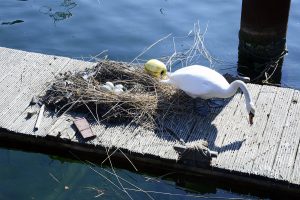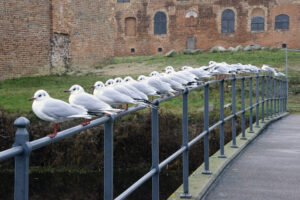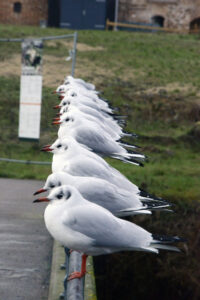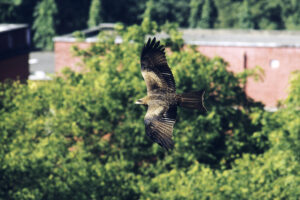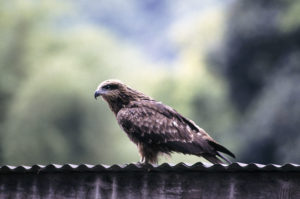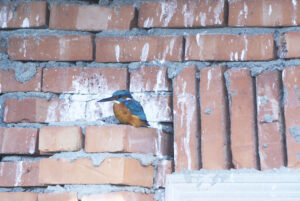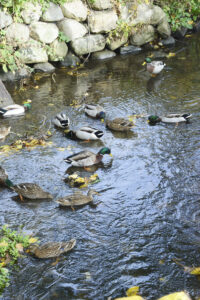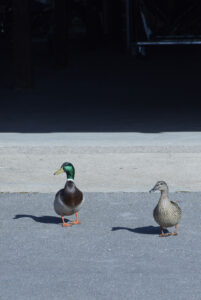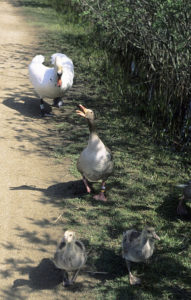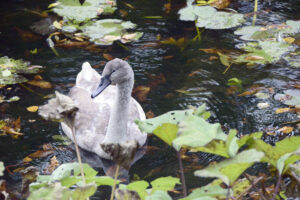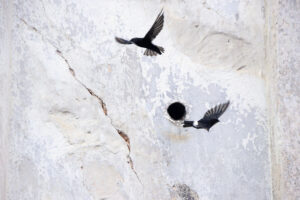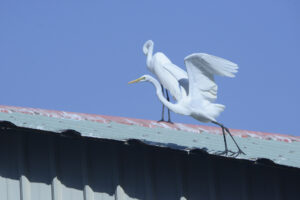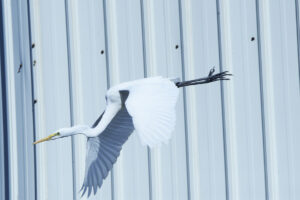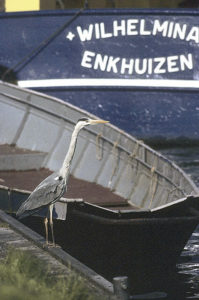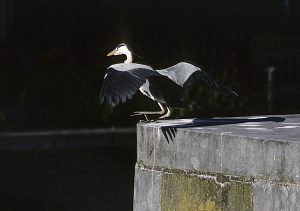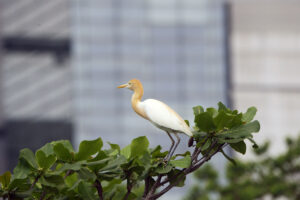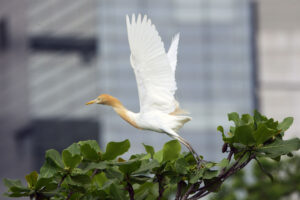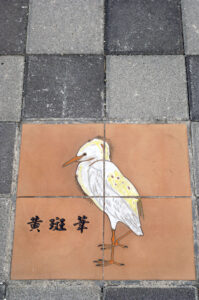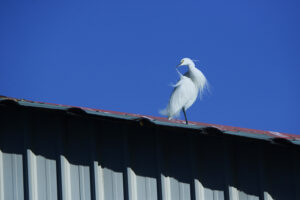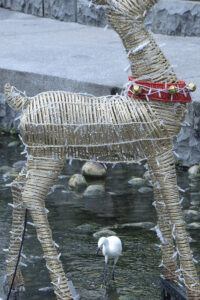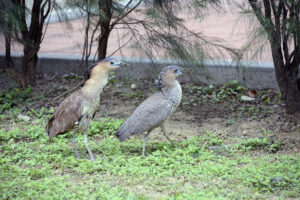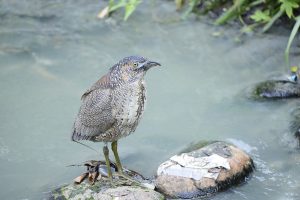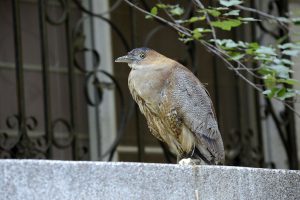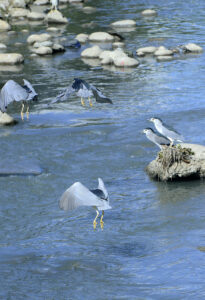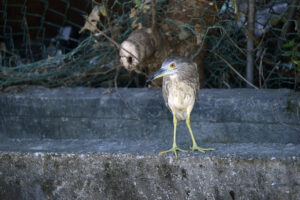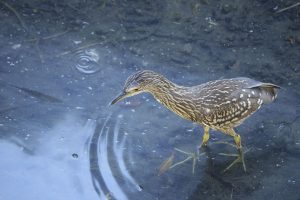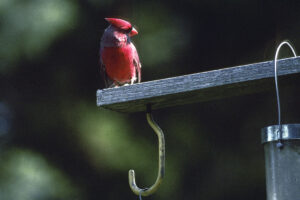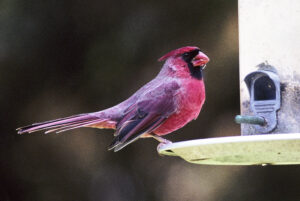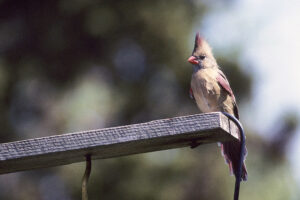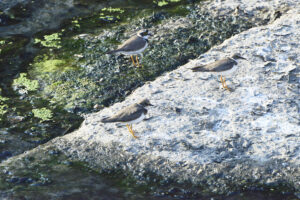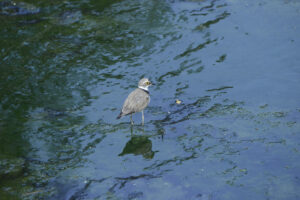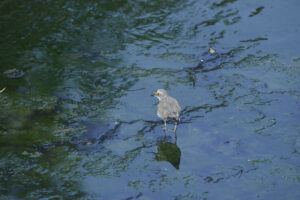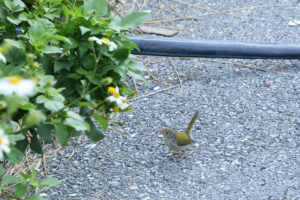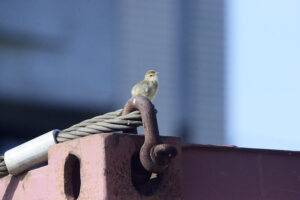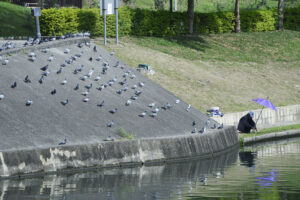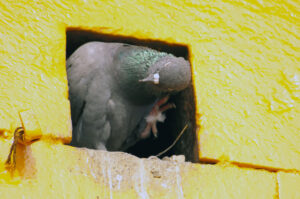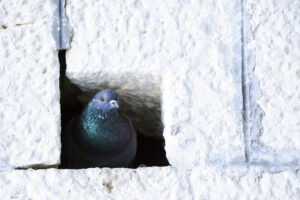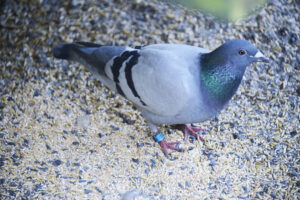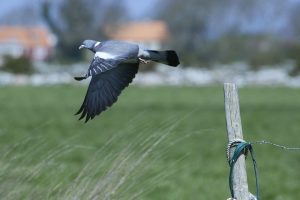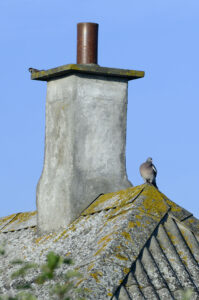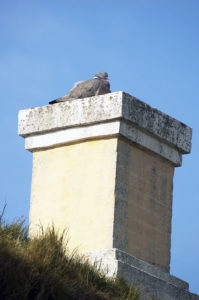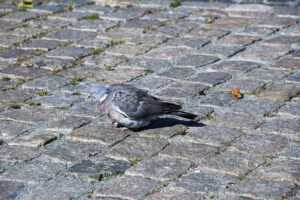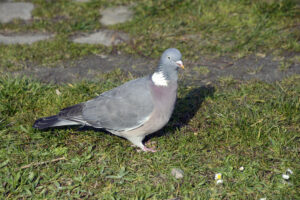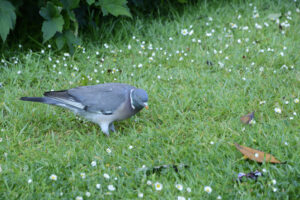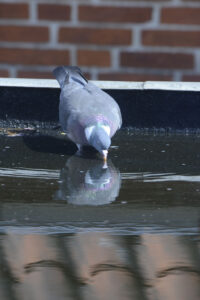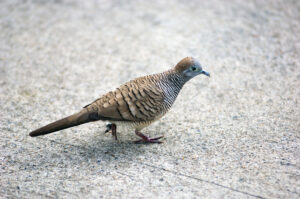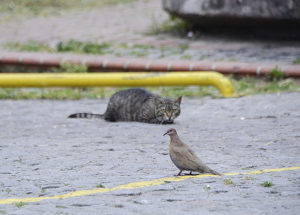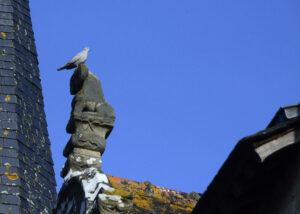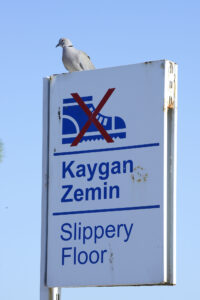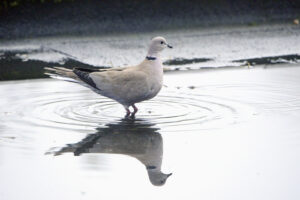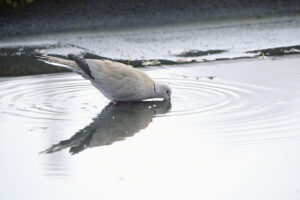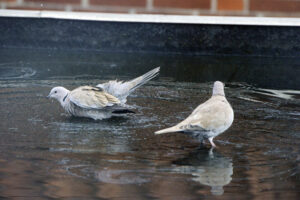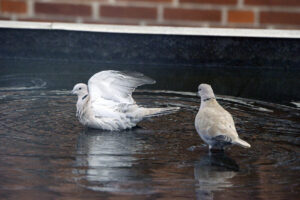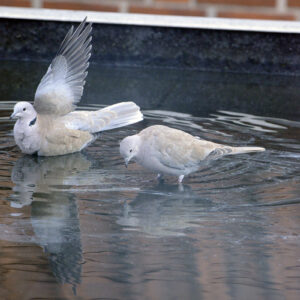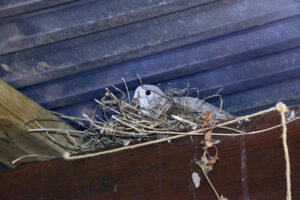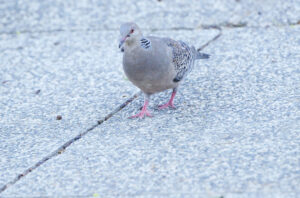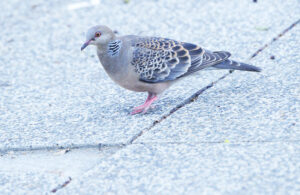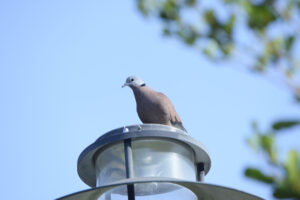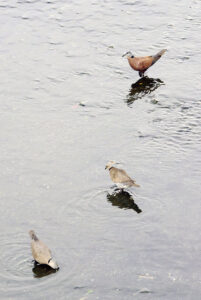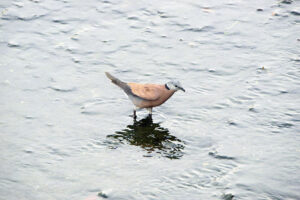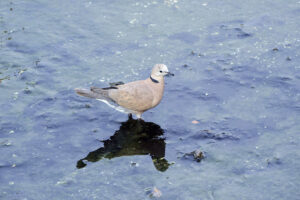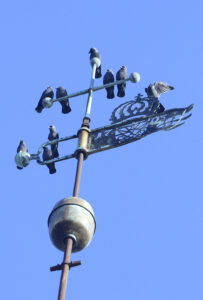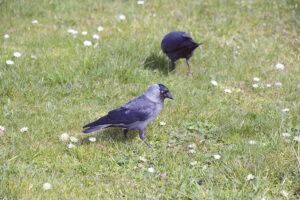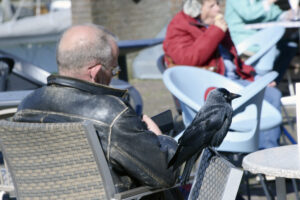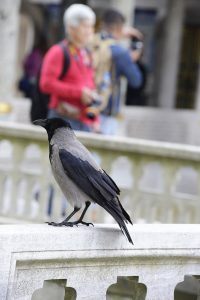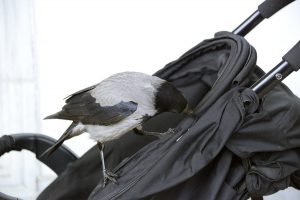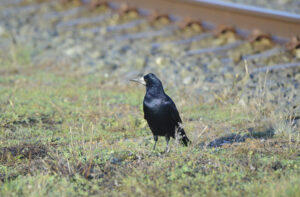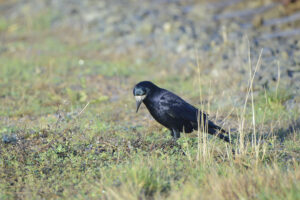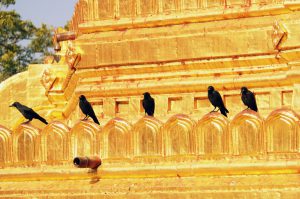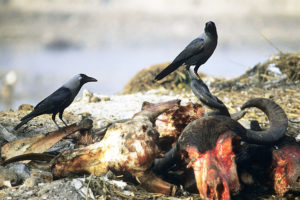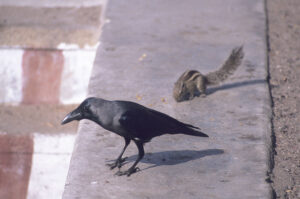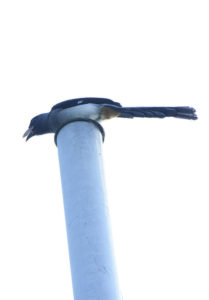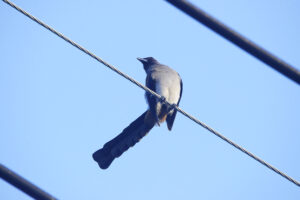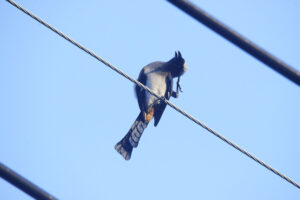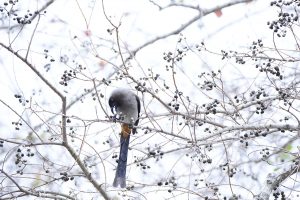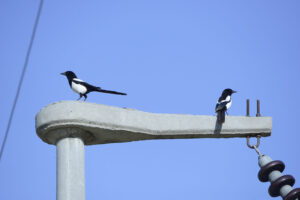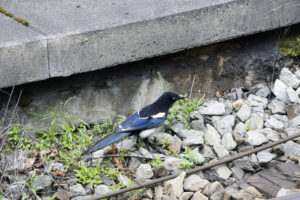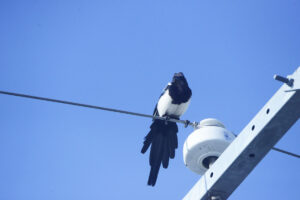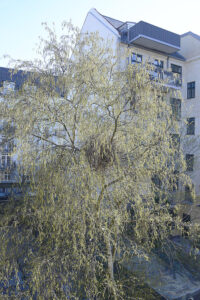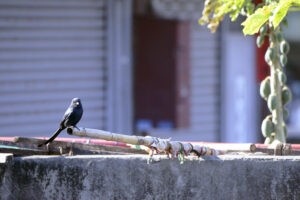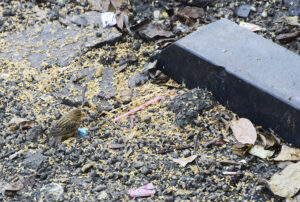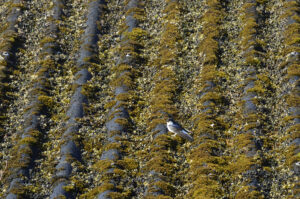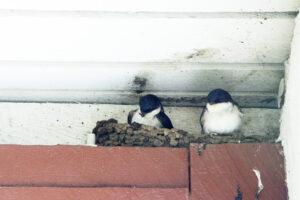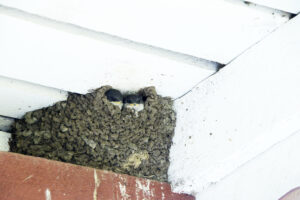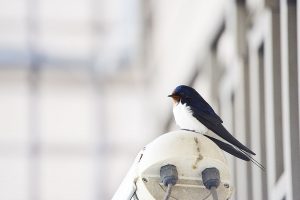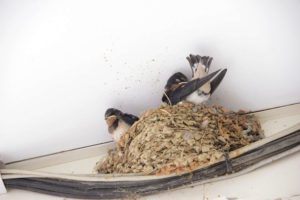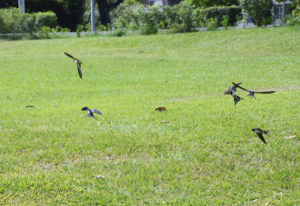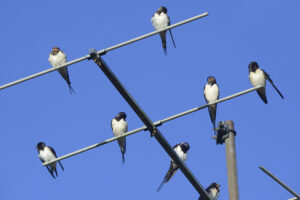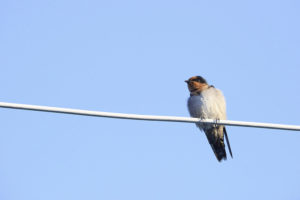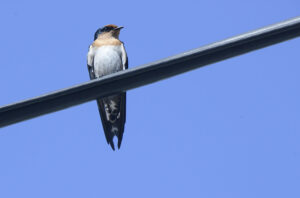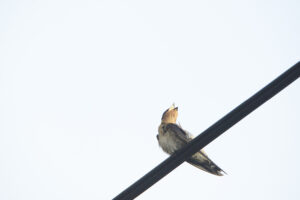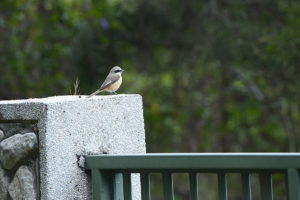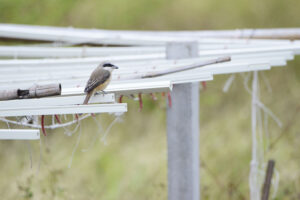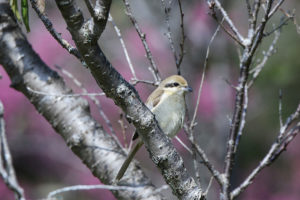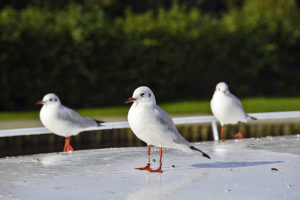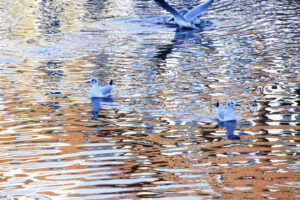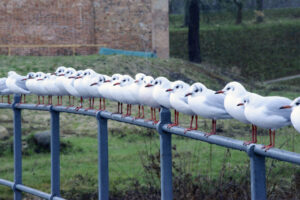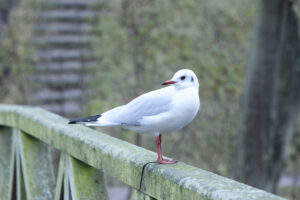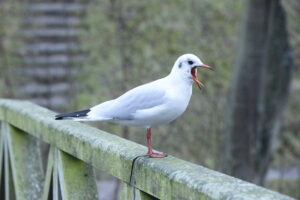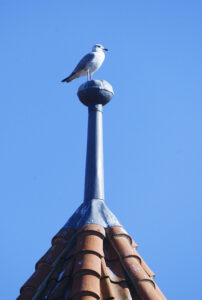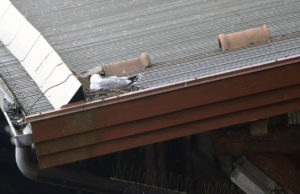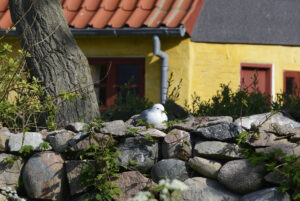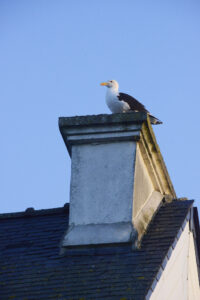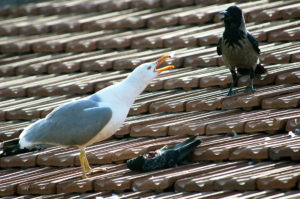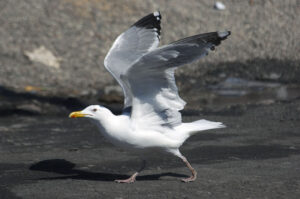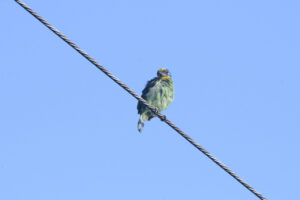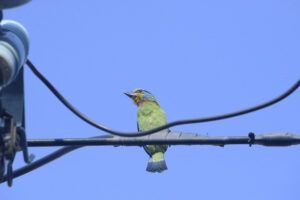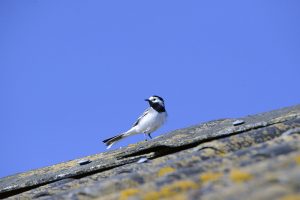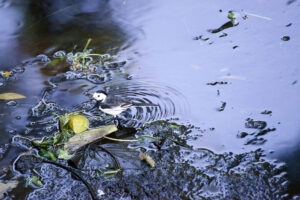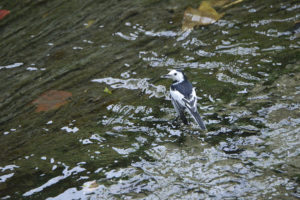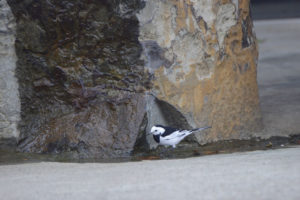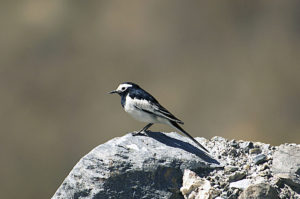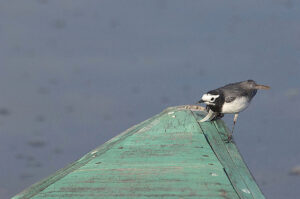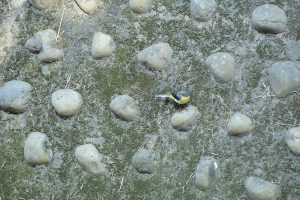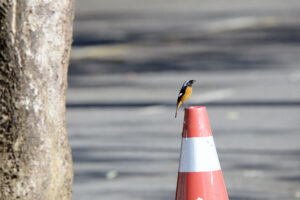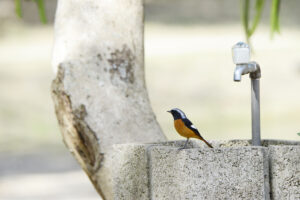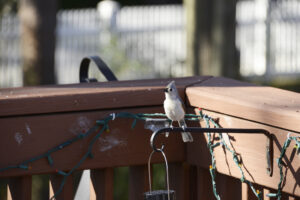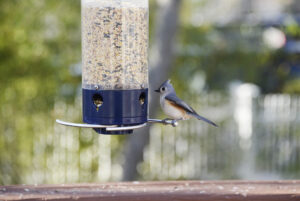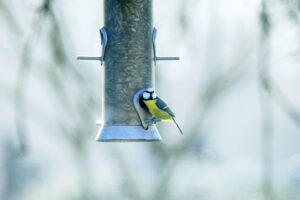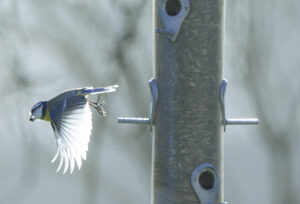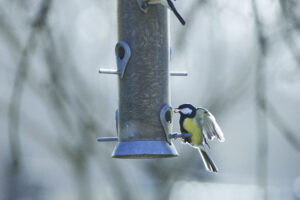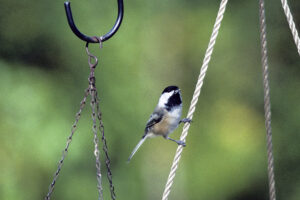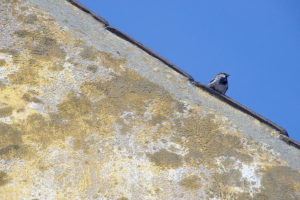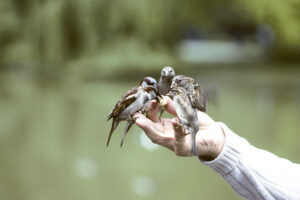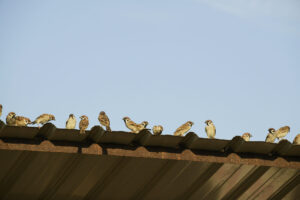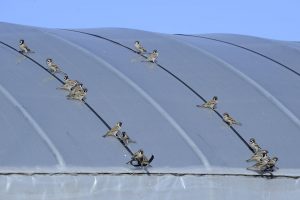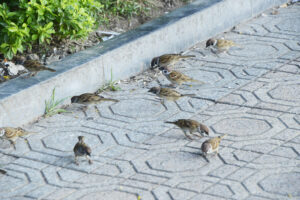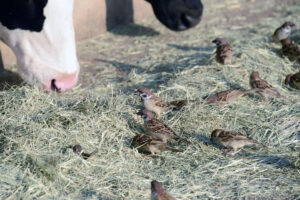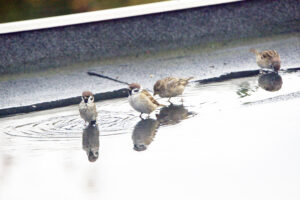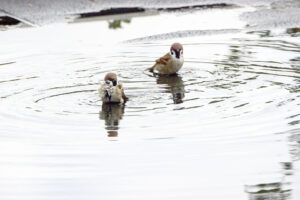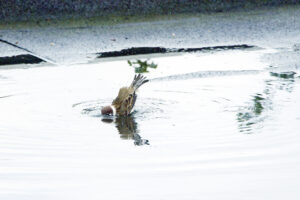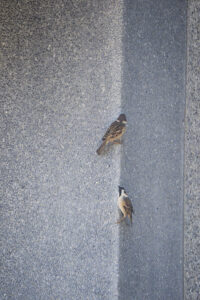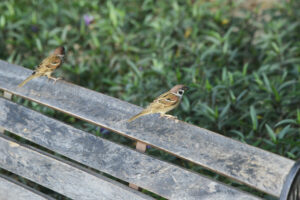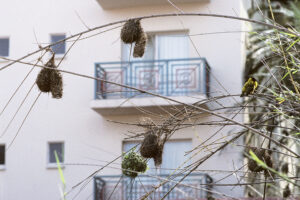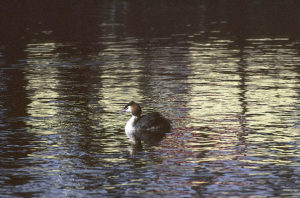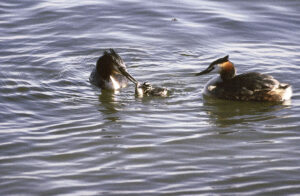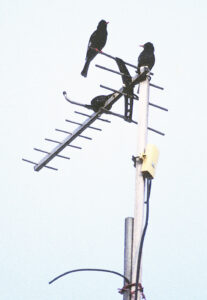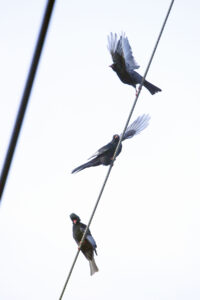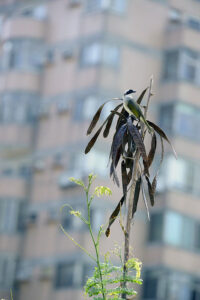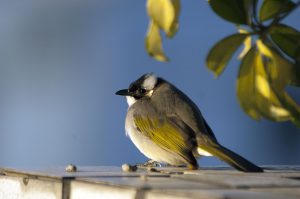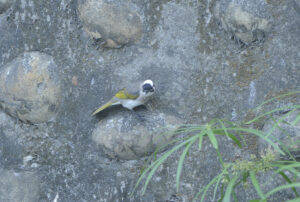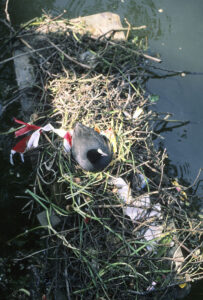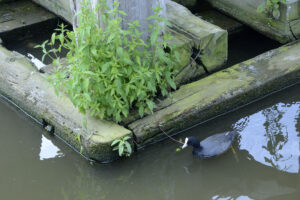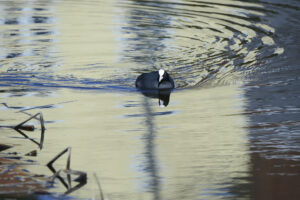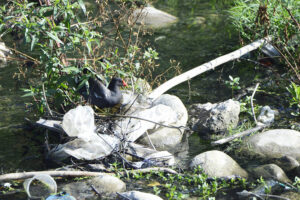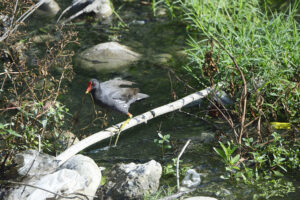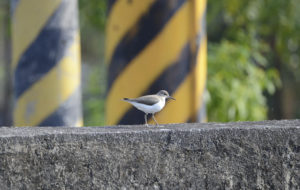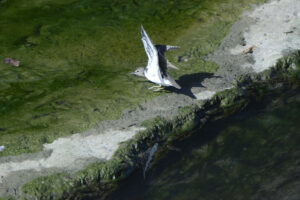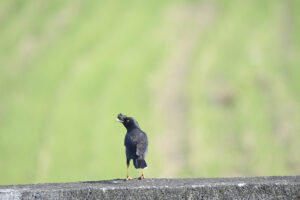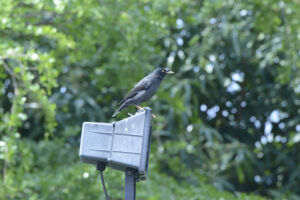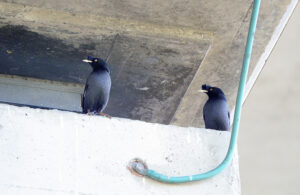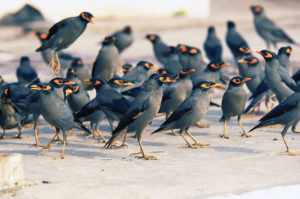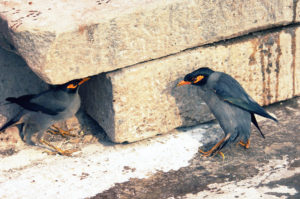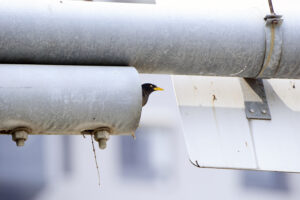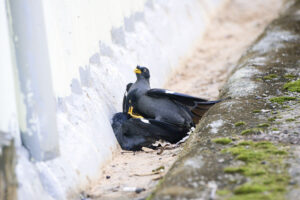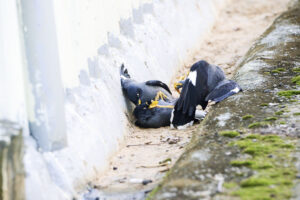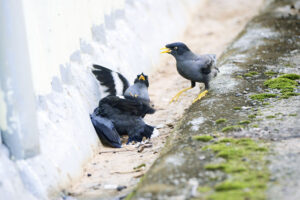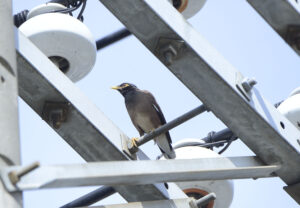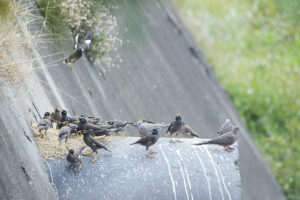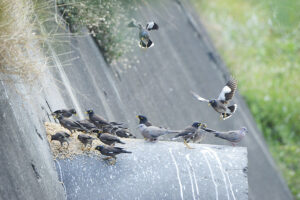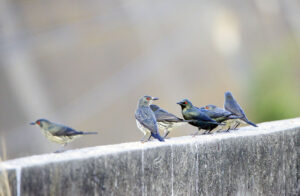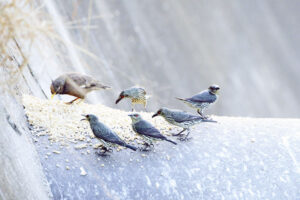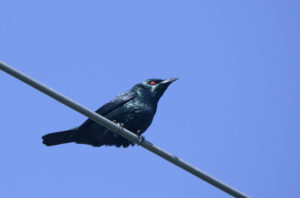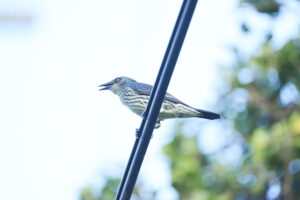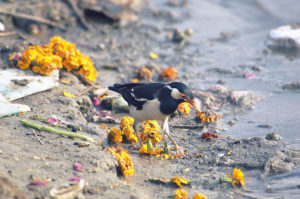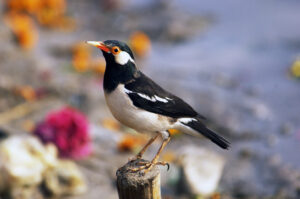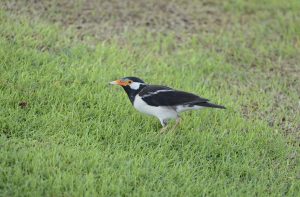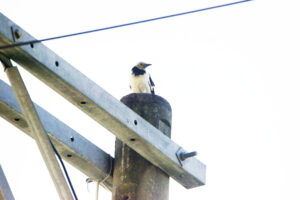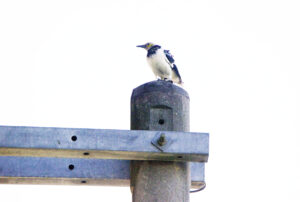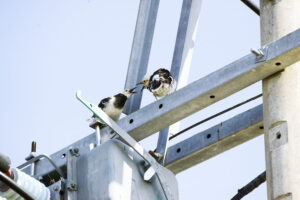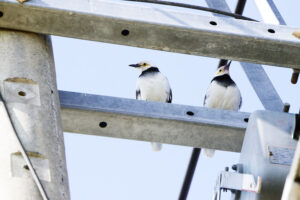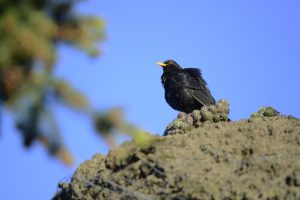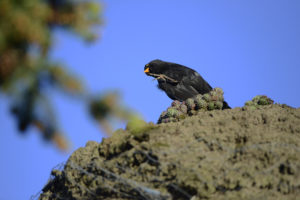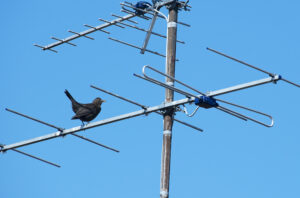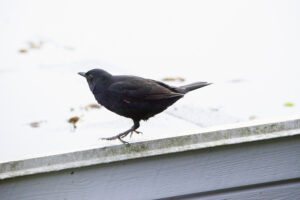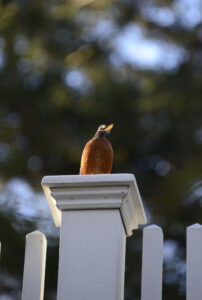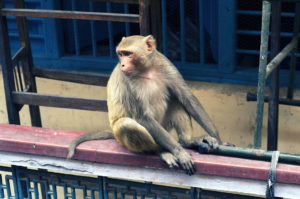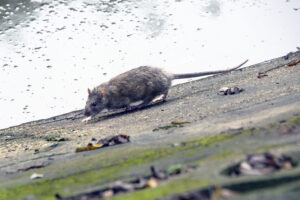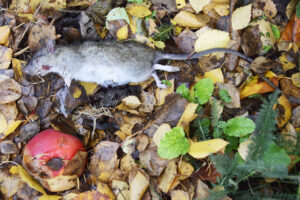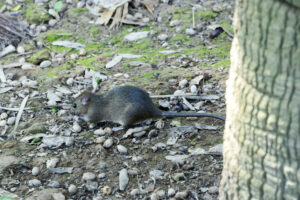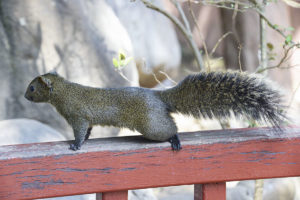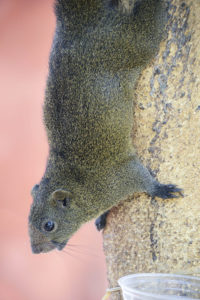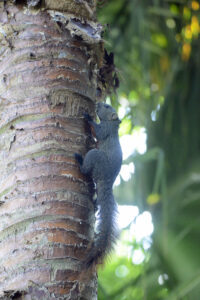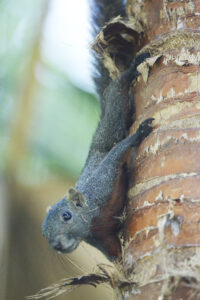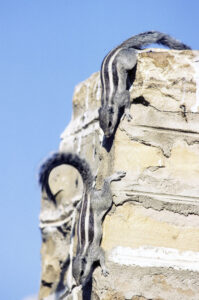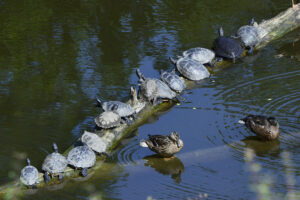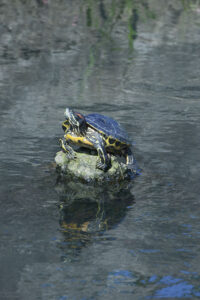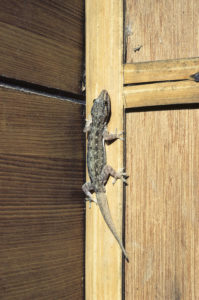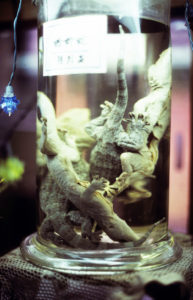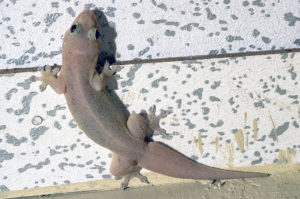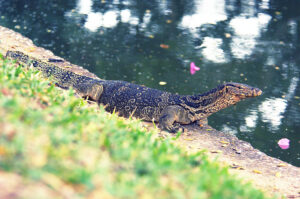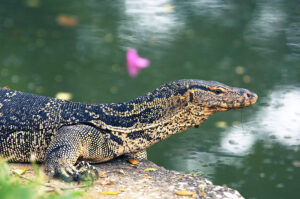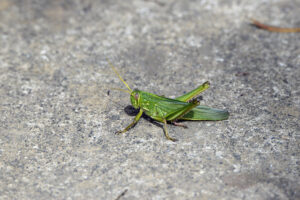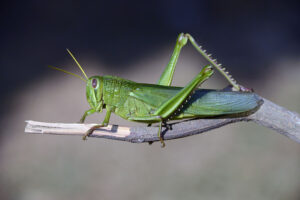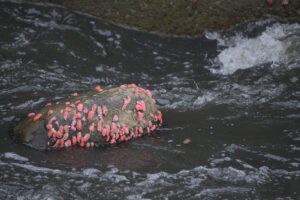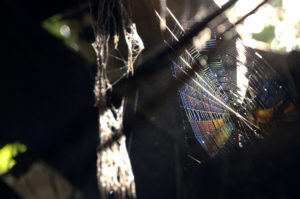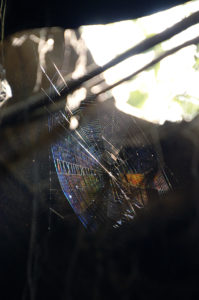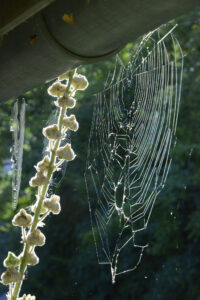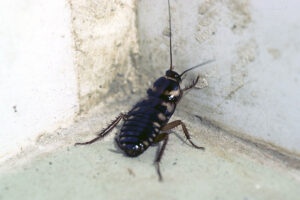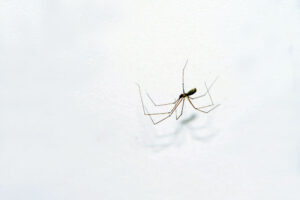Urban animal life
Some mute swans (Cygnus olor) build their nest in the most unlikely places. In this picture, swans have occupied a pontoon in a canal in Copenhagen, Denmark, oblivious of passing people or tourist boats. (Photo copyright © by Kaj Halberg)
This red-bellied squirrel (Callosciurus erythraeus, subspecies taiwanensis) is feeding on food, intended for birds, near the Confucius Temple, Tainan, southern Taiwan. Where they are regularly fed, these otherwise rather shy squirrels often become remarkably tame. (Photo copyright © by Kaj Halberg)
Black-headed gulls (Chroicocephalus ridibundus) in winter plumage, resting on the rail of a foot bridge across the moat of Nyborg Castle, Funen, Denmark. They lined up, when I approached the bridge, so presumably people had been feeding them regularly. (Photos copyright © by Kaj Halberg)
Tree sparrow (Passer montanus), sitting on a sculpture in a Daoist temple, depicting a dragon, Taichung, Taiwan. – Dragons and other aspects of Daoism are described on the page Religion: Daoism in Taiwan. (Photo copyright © by Kaj Halberg)
On this page, families, genera, and species are presented in alphabetical order. The etymology of the bird names is mainly taken from Jobling, J.A. 2010. The Helm Dictionary of Scientific Bird Names. Christopher Helm, London.
In case you find any errors, I would be grateful to receive an email. You may use the address at the bottom of the page.
Birds
Accipitridae Hawks, eagles, and allies
A huge family, comprising about 66 genera and c. 250 species of small to large raptors, distributed worldwide, with the exception of Antarctica.
The family name is derived from the Latin accipiter (‘hawk’), from accipere (‘to grasp’), naturally alluding to the sharp talons.
Milvus Kites
A small genus with 3-4 species, erected in 1799 by French naturalist Bernard Germain de Lacépède (1756-1825).
The generic name is the classical Latin name of the red kite (M. milvus).
Milvus migrans Black kite
A very widespread species, divided into 5 subspecies. It is found from central and southern Europe and northern Africa eastwards across Asia to Japan and Taiwan, and thence southwards to New Guinea and Australia.
The specific name is derived from the Latin migrare (‘to migrate’), alluding to the northernmost populations being migratory.
The rather pale subspecies govinda is distributed from eastern Pakistan eastwards across warmer parts of India and Sri Lanka to Indochina and the Malay Peninsula. It is often observed in urban areas. In the higher parts of the Himalaya, it is replaced by subspecies lineatus, which is widespread in Central and East Asia.
The subspecific name govinda alludes to the Hindu god Krishna, an avatar (incarnation) of the mighty god Vishnu. It is told that Krishna persuaded people who lived beneath the mountain Govardhana to worship the mountain instead of the rain god Indra, as he was of the opinion that the mountain, rather than the rain god, provided them with nourishment. Indra got furious, when the people no longer worshipped him and, as a punishment, sent torrential rain in order to drown people and cattle. However, Krishna protected them by raising the mountain, so that they could seek shelter beneath it. Indra acknowledged the superiority of Krishna, giving him the name Govinda, meaning ‘protector of cattle’.
Krishna and other Hindu gods are described on the page Religion: Hinduism.
Black kite, ssp. govinda, and a feral pigeon (Columba livia), Udaipur, Rajasthan, February 1, 2003. (Photo copyright © by Kaj Halberg)
Indian black kite, Varanasi, Uttar Pradesh. (Photo copyright © by Kaj Halberg)
Indian black kite on a house roof, Pokhara Nepal. (Photo copyright © by Kaj Halberg)
Alcedinidae Kingfishers
Kingfishers, comprising about 114 species of small to medium-sized, often brilliantly coloured birds, are characterized by having a large head, a long, sharp, pointed bill, and very short legs. As their name implies, most of these birds eat fish, although many species live away from water, eating mainly small invertebrates.
These birds are divided into three subfamilies: river kingfishers (Alcedininae), tree kingfishers (Halcyoninae), and water kingfishers (Cerylinae). One species of the former subfamily is presented below, whereas members of the other two subfamilies are described on the page Animals – Birds: Birds in the Himalaya.
Alcedo
A small genus with 7 species, all feeding almost exclusively on fish. 4 species are restricted to warmer parts of Asia, 2 to sub-Saharan Africa. The seventh species is presented below.
The generic name is the classical Latin word for kingfisher.
Alcedo atthis Common kingfisher
This bird has a very wide distribution, from western Europe across Asia to Sakhalin and Japan, and southwards to North Africa, Iraq, Sri Lanka, Indonesia, and New Guinea.
There are three possible explanations to the specific name, all from the Greek mythology. 1) A handsome, richly dressed Indian youth, son of Limniace, nymph of the Ganges. 2) A beautiful young woman of Lesbos, favourite of the female poet Sappho (c. 630-570 B.C.). 3) An Athenian princess, daughter of King Cranaus and his wife Pedias. Jobling (2010) favours the Indian youth.
The eastern subspecies bengalensis is fairly common in Taiwan, mainly in the lowland. These birds were all observed along drainage canals in Taichung. In the upper picture, the bird is sitting on a stick, which has been stuck into an outlet pipe. It seems that this stick is being used as a night roost for a heron, judging from the smudges of dung on the wall. (Photos copyright © by Kaj Halberg)
Anatidae Swans, geese, and ducks
At present, this large worldwide family contains 43 genera with about 146 species.
Anas
Following genetic studies, this formerly very large genus has been divided into 7 genera, including Spatula and Mareca.
The generic name is the classical Latin word for duck.
Anas platyrhynchos Mallard
This well-known bird is very widely distributed across subarctic, temperate, and subtropical areas of North America, Eurasia, and North Africa, southwards to Mexico, Morocco, Egypt, Pakistan, and China, and it has also been introduced to many other places as a hunting object, including South America, New Zealand, Australia, and South Africa.
The drake is a gorgeous bird in breeding plumage, with grey sides, purple breast, and glossy-green head, with a blue shine from certain angles. The female is a uniform speckled brown.
The specific name is derived from Ancient Greek platys (‘broad’) and rhynkhos (‘bill’).
Mallards, feeding in a canal, Ørbæk, Funen, Denmark. (Photo copyright © by Kaj Halberg)
This pair of mallard are standing in front of a restaurant in the city of Nyborg, Denmark. (Photo copyright © by Kaj Halberg)
Anser Grey geese
A genus with 11 species, distributed in arctic and temperate areas of the Northern Hemisphere.
The generic name is the classical Latin word for goose.
Anser anser Greylag goose
This species is widely distributed in northern Eurasia, from Iceland and Britain across northern Europe and Central Asia to northern China, with a scattered occurrence in south-eastern Europe, Turkey, Iraq, and Iran. In many countries, the species is now breeding in city parks, where it often becomes remarkably confiding – sometimes even showing a threatening attitude towards people.
Domestic geese are descended from the greylag goose. In some places, including North America and Australia, domestic geese have escaped to form feral populations.
This child is feeding greylag geese between bars in a fence, surrounding St. James’ Park, London. (Photo copyright © by Kaj Halberg)
When they have goslings, greylag geese are often so bold that they sometimes threaten passing people. This male goose in a city park in Copenhagen, Denmark, is hissing at me because of its goslings in the foreground, but is itself being threatened by a male mute swan (Cygnus olor). (Photo copyright © by Kaj Halberg)
Branta Brent geese, brant geese
A small genus with 6 species, breeding in arctic, subarctic, and temperate regions of the Northern Hemisphere, with the exception of the Hawaiian goose (Branta sandvicensis), which was originally restricted to Hawaii, but has been introduced elsewhere.
The generic name is a Latinized form of brandgás (‘burnt goose’), the Old Norse name of the brent goose (Branta bernicla), referring to the mainly black plumage of this species. In English, ‘burnt’ became ‘brent’.
Branta canadensis Canada goose
This goose, which is native to northern North America, has been introduced to many other countries. It arrived in Britain in the 1600s, when a few birds were released in St. James’s Park in London. Since then, numbers have exploded, and today the population is over 150,000 birds. It was introduced to Sweden in the 1920s, and today the population is estimated to be around 100,000 individuals.
The Canada goose is very bold and has been able to establish populations in urban areas, where it has no natural predators. In many areas, it has been declared a pest because of its noise, droppings, and aggressive behaviour.
Canada geese in a canal, Brugge, Belgium. (Photo copyright © by Kaj Halberg)
Cygnus Swans
Members of this genus, comprising 6 long-necked birds, are distributed on all continents except Antarctica. Genetic research indicates that the coscoroba swan (Coscoroba coscoroba) of South America is not a true swan, but more closely related to geese or shelducks.
The generic name is a Latinized form of the classical Greek word for swan, kyknos.
Cygnus olor Mute swan
In 1984, the mute swan was elected the national bird of Denmark – an appropriate choice, as it is very common. This was not always the case. In the 1800s, swans were hunted in Denmark, and by 1920, only three or four pairs were breeding in the vicinity of Copenhagen. Swans were protected in 1926, and the mute swan soon began spreading across the country.
In his fairy tale The Ugly Duckling, Danish poet Hans Christian Andersen relates the fate of a cygnet, which is ostracized by its fellow fowl in a farmyard, where it has been hatched together with ducklings. It has to undergo much suffering, before it realizes that it has matured into a beautiful swan. In reality, this story is about the fate of Andersen himself.
The mute swan is native to northern Europe, from southern Norway and southern Finland, southwards to southern France and Romania, and from Ireland eastwards to western Russia and Ukraine, and with patchy breeding occurrence in the Balkans, Turkey, and Central Asia, eastwards to southern Siberia, Mongolia, and northern China. It has also been introduced elsewhere, including North America, Australia, New Zealand, and South Africa.
As opposed to the other northern European swans, the whooper swan (C. cygnus) and Bewick’s swan (C. columbianus ssp. bewickii), the mute swan is not very vocal, hence the appellation mute.
The specific name is the classical Latin word for swan.
Many pictures, depicting mute swans, are shown on the page Animals – Birds: Swans, where also the whooper swan and Bewick’s swan are described.
Some mute swans build their nest in the most unlikely places. In these pictures, swans have occupied pontoons in a canal in Copenhagen, oblivious of passing people or tourist boats. (Photos copyright © by Kaj Halberg)
Young mute swan, feeding in a moat around Nyborg Castle, Funen, Denmark. The plant in the foreground is butterbur (Petasites hybridus), in the background floating leaves of white waterlily (Nymphaea alba). (Photo copyright © by Kaj Halberg)
In severe winters, many starving water birds gather in harbours, where conditions are often less harsh than in open areas. This woman in Lausanne, Switzerland, is feeding various bird species, including mute swans, coots (Fulica atra) (see Rallidae), tufted ducks (Aythya fuligula), black-headed gulls (Chroicocephalus ridibundus) (see Laridae), and feral pigeons (Columba livia) (see Columbidae). (Photo copyright © by Kaj Halberg)
Apodidae Swifts
This family contains about 19 genera and 113 species of fast-flying birds, which catch insects in the air. They are superficially similar to swallows, but are not even distantly related to them, the resemblance being a result of convergent evolution due to similar life styles.
Apus Typical swifts
A genus with about 20 species, distributed in Eurasia and Africa, and on islands in the Pacific Ocean.
The generic name is the classical Latin word for swifts, derived from Ancient Greek a (‘without’) and pous (‘foot’). Due to the tiny, weak legs of these birds, the Ancients believed that they were a type of swallow without feet.
Apus nipalensis House swift
Formerly, this bird was classified as a subspecies of little swift (A. affinis), but today, most authorities regard populations, distributed from Nepal eastwards to Japan, and thence southwards through Indochina and Malaysia to Indonesia and the Philippines, as a separate species.
The specific name refers to Nepal. Presumably, the type specimen was collected there.
House swifts, feeding among buildings in the town of Bandipur, Nepal. (Photo copyright © by Kaj Halberg)
House swifts in front of their breeding site, a hole in a wall, Bandipur. (Photo copyright © by Kaj Halberg)
Colony of house swift on a residential building, Taichung, Taiwan. (Photo copyright © by Kaj Halberg)
Ardeidae Herons, egrets, and bitterns
Herons comprise about 64 species of long-legged and long-beaked, fish-eating water birds, distributed almost worldwide. Some species are called egrets, mainly birds with ornate plumes during the breeding season, whereas birds of the genera Botaurus, Ixobrychus, and Zebrilus are called bitterns.
Ardea
A genus with about 13 species of mainly large herons, distributed almost worldwide.
The generic name is the classical Latin word for herons.
Ardea alba Great white egret
This large heron has an almost global distribution, found in Europe, Africa, most of Asia, Australia, and the Americas. Traditionally, it was placed in the genus Egretta (below), mainly due to its white plumage. Some authorities have also placed it in a separate genus, Casmerodius. However, it shows many affinities to large herons in the genus Ardea.
The specific name is Latin, meaning ‘white’.
Subspecies modesta of the great white egret is common in the lowlands of Taiwan. This picture shows a bird, resting on a boat, Lanyan River, north-eastern Taiwan. (Photo copyright © by Kaj Halberg)
Several great white egrets and two little egrets (Egretta garzetta), resting on the roof of a storage building, Taichung, Taiwan. (Photo copyright © by Kaj Halberg)
Preening great white egret, Taichung. (Photo copyright © by Kaj Halberg)
This one takes of from a building, Taichung. (Photos copyright © by Kaj Halberg)
Ardea cinerea Grey heron
The grey heron is distributed in the major part of Asia, Europe, Africa, and Madagascar. Formerly, this species was a very shy bird, but in later years it has adapted to a life in cities. In America, it is replaced by the similar, slightly larger great blue heron (A. herodias).
The specific name is derived from the Latin cineris (‘ashes’), thus ‘ash-coloured’.
Other pictures, depicting grey herons, are shown on the pages Fishing, Animals – Birds: Birds in Taiwan, and Birds in the Indian Subcontinent, whereas the great blue heron is described on the page Animals – Birds: Birds in the United States and Canada.
This grey heron was encountered in the harbour of Enkhuizen, West-Friesland, Holland. (Photos copyright © by Kaj Halberg)
Bubulcus ibis Cattle egret
This species is very widely distributed, found in most warmer areas of the world, only avoiding rain forests and desert areas. Originally, it was native to southern Spain and Portugal, the northern half of Africa, and across the Middle East and the Indian Subcontinent eastwards to Japan, and thence southwards to northern and eastern Australia.
However, in the late 1800s it began expanding its range into southern Africa, and in 1877 it was observed in northern South America, having apparently flown across the Atlantic Ocean. By the 1930s, it had become established as a breeding bird in this area, rapidly spreading to North America, where it is now found as far north as southern Canada. In later years, it has also spread northwards in Europe.
The generic name is Latin, meaning ‘cowherd’, referring to the fact that it often follows cattle to snap grasshoppers and other small animals, flushed by the grazers. It is also often observed in newly ploughed fields. The specific name is the classical Greek term for ibises. Why it was applied to the cattle egret is not clear.
Today, some authorities split the cattle egret into two species, the western (B. ibis) and the eastern (B. coromandus). Apart from minor differences, they are identical, so why this split was made, is incomprehensible. I prefer to regard all cattle egrets as a single species.
The cattle egret is a common resident in the lowlands of Taiwan, also in urban areas. This bird in breeding plumage takes off from a tree in Central Taiwan Science Park, Taichung. (Photos copyright © by Kaj Halberg)
Cattle egret, depicted on tiles, Taichung. (Photo copyright © by Kaj Halberg)
Egretta Egrets
A genus with 12 small to medium-sized herons, the major part breeding in warmer areas around the globe. Most members have black legs with bright yellow toes, and many develop ornate plumes during the breeding season.
The generic name is derived from Provençal French aigrette, a diminutive of aigron (‘heron’).
Egretta garzetta Little egret
The little egret is found in most tropical and subtropical areas of Europe, Africa, Asia, and Australia. In 1994, a small population was established on the Caribbean island Barbados, and the species has since spread to other Caribbean islands and to the Atlantic coast of the United States. In many places, it has adapted to a life in cities.
The specific name is the Italian name for the bird.
A close relative, the snowy egret (E. thula), is presented on the page Animals – Birds: Birds in the United States and Canada.
Little egret is very common in the lowlands of Taiwan. This one is resting in a drainage canal in the city of Taichung. (Photo copyright © by Kaj Halberg)
Standing on a house roof in Taichung, this little egret is preening its plumes. (Photos copyright © by Kaj Halberg)
This one is resting near an electric pole, Taichung. Judging from the excreta, it often uses the pole as a resting place. (Photo copyright © by Kaj Halberg)
This one is standing on a water pipe near a fountain, Tunghai University Park, Taichung. (Photo copyright © by Kaj Halberg)
Little egrets, feeding in a drainage canal, Taichung. (Photo copyright © by Kaj Halberg)
This one is also feeding in a drainage canal in Taichung, near a Christmas decoration, depicting a reindeer. (Photos copyright © by Kaj Halberg)
Gorsachius Smaller night-herons
A small genus with 4 species of small herons, 3 of which are found in warmer parts of Asia, one in sub-Saharan Africa. They were previously placed in the genus Nycticorax (below).
The generic name is derived from the name Ardea goisagi, which Dutch zoologist and museum director Coenraad Jacob Temminck (1778-1858) applied in 1836 to the Japanese night-heron (today called Gorsachius goisagi). In fact, Goi-sagi is the Japanese name for the black-crowned night-heron (below), derived from goi (‘fifth rank’) and sagi (‘heron’). In Japanese classical folklore, the all-powerful Emperor Daigo (reigned 897-930 A.D.) ordered a vassal to capture a black-crowned night-heron. Upon hearing the imperial command, the heron submitted itself to capture. The emperor was pleased that the heron had confirmed his omnipotence over nature as well as man, whereupon he granted it the title ‘king of the herons’ and the position of fifth rank in his court, and then released it unharmed. (Source: Jobling, 2010)
Gorsachius melanolophus Malayan night-heron
As a breeding bird, this species has a scattered occurrence, found in north-eastern and south-western India, in southern China and Indochina, and in Taiwan and the Philippines. The majority of the populations are resident, but north Indian and some Chinese birds are migratory, spending the winter in Malaysia and Indonesia. It also occurs in Sri Lanka in winter.
The main habitats of this species are forest and marshy areas, but in Taiwan it is fairly common in cities and city parks, where it can become remarkably confiding.
The pictures below are from the city of Taichung, Taiwan.
This pair of Malayan night-herons was encountered in a park. The bird to the left is probably a male in breeding plumage, showing deep blue lores and a long crest, whereas the other bird presumably is a female, which is not yet sexually mature, or has retained the immature plumage – a character known from females of this species. (See Chang 2000. Malayan Night Heron Gorsachius melanolophus breeding in immature plumage. Forktail 16, pp. 167-168). (Photo copyright © by Kaj Halberg)
Immature Malayan night-heron, foraging in a polluted stream. (Photo copyright © by Kaj Halberg)
This bird is sitting on its day-roost, a garden wall. (Photo copyright © by Kaj Halberg)
The windscreen of this long-term parked car is covered in guano, which has dropped from a Malayan night-heron nest in the tree above. (Photo copyright © by Kaj Halberg)
Nycticorax Night-herons
Today, this genus contains only 2 species, the black-crowned night-heron (below), which is distributed almost worldwide in warmer areas, and the Nankeen, or rufous, night-heron (N. caledonicus), which is distributed in Australia, New Zealand, Java, the Philippines, Papua New Guinea, New Caledonia, Palau, and the Solomon and Caroline Islands.
In historic times, 4 other species of the genus, which were all restricted to small islands in the Atlantic and Indian Oceans, have gone extinct.
The generic name is derived from Ancient Greek nyktos (‘night’) and korax (‘raven’), referring to the mainly nocturnal feeding habits of these birds, and to their hoarse, raven-like call.
Nycticorax nycticorax Black-crowned night-heron
This smallish heron is found in most warmer parts of the world, except in Australia, where it is replaced by the closely related rufous night-heron (N. caledonicus).
In Taiwan, the black-crowned night-heron is quite common and often confiding. These are resting in a drainage canal in the city of Taichung. (Photo copyright © by Kaj Halberg)
An adult and an immature bird, sitting on a wall along a drainage canal in Taichung. (Photos copyright © by Kaj Halberg)
These immature black-crowned night-herons were also observed in a drainage canal in Taichung. The bird in the lower picture is searching for fish. (Photos copyright © by Kaj Halberg)
Caprimulgidae Nightjars and nighthawks
This family of nocturnal or crepuscular birds is found on all continents except Antarctica. It is divided into 3 subfamilies, Caprimulginae (typical nightjars) with 14 genera and about 79 species, Eurostopodinae (eared nightjars) with 2 genera and 9 species, and Chordeilinae (nighthawks) with 3 genera and 10 species.
Caprimulgus Typical nightjars
A large genus with about 37 species, found in Eurasia, Africa, and Australia.
In the old days, these birds were often called goatsuckers, as it was believed that they would suck milk from goats at night. This belief dates back to Roman philosopher and naturalist Pliny the Elder (c. 23-79 A.D.), who called these birds caprimulgus, derived from capra (‘she-goat’) and mulgere (‘to milk’). He wrote: “Those called goat-suckers, which resemble a rather large blackbird, are night thieves. They enter the shepherds’ stalls and fly to the goats’ udders in order to suck their milk, which injures the udder and makes it perish, and the goats they have milked in this way gradually go blind.”
In 1758, the name caprimulgus was adopted by Swedish naturalist Carl Linnaeus (1707-1778), when he named the European nightjar Caprimulgus europaeus. In German, nightjars are still called Ziegenmelker (‘goat-milkers’).
Caprimulgus affinis Savanna nightjar
A widespread species, found from the Indian Subcontinent eastwards to Taiwan, and thence southwards through Indochina and the Philippines to Indonesia. It lives in a variety of habitats, including gravelly riverbeds, grasslands, inner beaches, and roadsides. It is common in Taiwan, where it has adapted to a life in urban areas, breeding on rooftops.
The specific name is Latin, meaning ‘related to’ or ‘similar to’ – presumably to another nightjar.
Savanna nightjar on its day roost on a rooftop, Taichung. (Photos copyright © by Kaj Halberg)
Cardinalidae
Members of this family, comprising 14 genera, were previously placed in the family Fringillidae (finches).
Cardinalis Cardinals
A small genus with 3 species, found from extreme south-eastern Canada southwards to north-western South America.
The generic and common names allude to the brilliant red plumage of the northern cardinal (below), which resembles the red robes of cardinals. Originally, cardinalis is Latin, meaning ‘principal’ or ‘chief’, short for cardinalis ecclesiae Romanae, that is ‘presbyters of the cardinal (chief) churches of Rome’.
Cardinalis cardinalis Northern cardinal
This bird, divided into 19 subspecies, is resident in a vast area, from extreme south-eastern Canada southwards to Florida, and thence westwards to the Dakotas, Wyoming, and Arizona, southwards through most of Mexico to northern Guatemala and Belize. It has also been introduced to southern California and Hawaii.
Male and female northern cardinal on a bird feeder, Mount Sinai, Long Island, New York State. (Photos copyright © by Kaj Halberg)
Charadriidae Plovers and lapwings
This family of small to medium-sized waders comprise about 10 genera with about 65 species. They are distributed almost worldwide, the vast majority near wetlands.
Charadrius Ringed plovers, dotterels
These birds, comprising about 32 species of mainly small waders, are found throughout the world, usually in wetlands.
The generic name is the classical Latin word for a yellowish bird, mentioned in Biblia Vulgata, a Latin translation of the Bible from the late 4th Century. The name was derived from the classical Greek term for a bird living in river valleys, kharadrios, derived from kharadra (‘ravine’).
Charadrius dubius Little ringed plover
This species has an enormous distribution, breeding in most of Europe, and in the Middle East, Central Asia, China, Japan, the Indian Subcontinent, Southeast Asia, the Philippines, and New Guinea.
The specific name means ‘doubtful’ in Latin, so named in 1776 by French naturalist and explorer Pierre Sonnerat (1748-1814), as he thought that the specimen, which he described the species from, might be a variant of the common ringed plover (C. hiaticula), whose plumage had been altered by climatic influence.
In Taiwan, subspecies curonicus of the little ringed plover is a rather common resident. In these pictures, adult (with a clear yellow eyering) and immature birds are feeding in a drainage canal in the city of Taichung. (Photos copyright © by Kaj Halberg)
Cisticolidae Cisticolas, prinias, and allies
Members of this family of tiny passerines, comprising about 26 genera with c. 160 species, were formerly placed in the large family Sylviidae, but have since been moved to a separate family.
Orthotomus Tailorbirds
A genus with about 13 tiny species, distributed from the Indian Subcontinent eastwards to southern China, and thence southwards through Indochina and the Philippines to Indonesia, with the largest diversity in the Philippines. Two species, which were formerly included in this genus, have been moved to the genus Phyllergates in the family Cettiidae.
The generic name is derived from Ancient Greek orthotomeo (‘to cut straight’), which, like the common name, alludes to the way the nest of these birds is constructed. The edges of a large leaf are pierced with the bill and then ‘sewn’ together with plant fibre or spider silk, forming a ‘sack’, in which the actual grass nest is built.
Orthotomus sutorius Common tailorbird
This bird is distributed from the Indian Subcontinent eastwards to southern China, and thence southwards through Indochina to the Malay Peninsula, with a disjunct population in Java. It is common in gardens and city parks.
The specific name is Latin, meaning ‘of a shoemaker’, derived from suere (‘to stitch’ or ‘to sew’).
The tailorbird plays a significant role in the delightful short story Rikki-Tikki-Tavi, which relates how a valiant young grey mongoose (Urva edwardsii) rids a garden of dangerous cobras (Naja naja). This story is included in the famous The Jungle Book (1894), by English author Rudyard Kipling (1865-1936). In the story, the tailorbird is named Darzee, which refers to one of the calls of the bird, rendered as whee-whee.
Common tailorbird in the park around Hanoi Airport, Vietnam. (Photos copyright © by Kaj Halberg)
Prinia Prinias
About 30 species of the long-tailed prinias, also known as wren-warblers, are distributed across Africa and Asia.
The generic and common names are the Javan name of the bar-winged prinia (P. familiaris).
Prinia inornata Plain prinia
The plain prinia is found in the Indian Subcontinent, Indochina, China, and Taiwan, with an isolated population on the Indonesian island Java.
The specific name is derived from the Latin in (‘not’) and ornatus (‘adorned’), alluding to the plain plumage of this bird.
Subspecies flavirostris of plain prinia is endemic to Taiwan, where it is very common in grassy areas of the lowland. This one is sitting in a very unusual place, on a wire at a construction site in Taichung. (Photo copyright © by Kaj Halberg)
Columbidae Pigeons and doves
A large family with about 50 genera and c. 345 species. The word pigeon generally denotes larger species, dove smaller species. These birds are found on all continents except Antarctica.
Columba
A rather large genus with about 35 species, widely distributed in the Old World. Previously, a number of American pigeons were placed in this genus, but they have been moved to a separate genus, Patagioenas.
The generic name is Latin, meaning ‘dove’, the feminine form of columbus (‘male dove’), a Latinized version of Ancient Greek kolumbos (‘diver’). This name was applied by Greek comic-writer Aristophanes (c. 446-386 B.C.) to the common rock pigeons, due to the ‘swimming’ motion made by their wings in flight.
Columba livia Rock pigeon
It is believed that in the wild, this species was originally found in southern Europe, northern Africa, and from the Middle East eastwards to Afghanistan and India, with isolated populations in Ireland, Scotland, the Faroe Islands, the Azores, Madeira, the Canary Islands, and the Cape Verde Islands.
However, the bird was domesticated at a very early stage and has since been brought to almost every corner of the world. Over time, more than a thousand breeds have evolved. In numerous cities around the world, birds have escaped to form huge feral populations. Feeding these birds is often a very popular occupation, despite the fact that they are a nuisance, dropping their guano everywhere, and maybe also spreading contagious diseases.
The specific name stems from Theodore Gaza’s work from 1476, Aristotelis de natura animalium, in which he translates the classical Greek word for dove, peleia (probably derived from pellos = ‘dark-coloured’), into livia, derived from the Latin livens (‘lead-coloured’), ultimately from livere (‘being bluish’).
Numerous feral pigeons, being fed on Durbar Square, Kathmandu, Nepal. (Photo copyright © by Kaj Halberg)
Warmly dressed on a chilly spring morning, a little boy has fun chasing the feral pigeons on Durbar Square. (Photo copyright © by Kaj Halberg)
Every morning, hundreds of feral pigeons are being fed around the Buddhist Bodhnath Stupa, Kathmandu, Nepal. (Photos copyright © by Kaj Halberg)
Numerous feral pigeons in a city square, San Juan, Puerto Rico. (Photo copyright © by Kaj Halberg)
Feral pigeons are also being fed many places in Taiwan. These are gathered on a cemented slope along the Han River, Taichung. (Photo copyright © by Kaj Halberg)
Feral pigeons, resting on a building along the Ganges River, Varanasi, India. (Photo copyright © by Kaj Halberg)
This feral pigeon is scratching its head. It breeds in a hole in a wall along the Ganges River. (Photo copyright © by Kaj Halberg)
This one is sitting in a hole in a wall in the city of Ragusa, Sicily. (Photo copyright © by Kaj Halberg)
Pigeon racing is a popular sport in many countries. This homing pigeon had got lost and was now resting on the small island Hirsholm in Kattegat, Denmark. (Photo copyright © by Kaj Halberg)
Columba palumbus Wood pigeon
As the common name implies, this species was once a shy bird, restricted to forests. However, since the 1960s it has adapted to a life in cities, where it is now very common and confiding. It is distributed all over Europe, the Middle East, and Morocco, with isolated populations in Central Asia and the western part of the Himalaya.
The specific name is derived from the Latin palumbes, the classical word for the wood pigeon.
The wood pigeon may be identified by the white patches on the hindneck and wings. This one takes off from a pole near Säby Läge, Öland, Sweden. (Photo copyright © by Kaj Halberg)
Wood pigeon on a house roof, Lyø, southern Funen, Denmark. A house sparrow (Passer domesticus) is sitting on the chimney. (Photo copyright © by Kaj Halberg)
This wood pigeon is sitting on a house chimney on the island of Fanø, Denmark. (Photo copyright © by Kaj Halberg)
Wood pigeons, feeding in the city of Nyborg, Funen, Denmark. (Photos copyright © by Kaj Halberg)
This wood pigeon is feeding on the lawn in front of the cathedral in Quimper, Bretagne. The white flowers are common daisies (Bellis perennis). (Photo copyright © by Kaj Halberg)
Wood pigeon, drinking from a puddle on the roof of a garage, Jutland, Denmark. (Photo copyright © by Kaj Halberg)
Geopelia
A genus with 5 species of small, long-tailed doves, native to Southeast Asia and Australasia.
The generic name is derived from Ancient Greek geo (‘ground’) and peleia (‘dove’).
Geopelia striata Zebra dove
This small dove is native from southern Thailand southwards to Indonesia, living in open areas, including shrubberies, farmland, parks, and gardens. It is a popular cage bird, and many populations have been established outside its native range from escaped birds.
Zebra dove, walking on a street, Bangkok, Thailand. (Photo copyright © by Kaj Halberg)
Spilopelia
Formerly, members of this genus were included in the genus Streptopelia (below), but studies on vocalization, together with genetic analyses, led to the conclusion, that two birds of that genus, the spotted dove and the laughing dove (both presented below), differed sufficiently from the other members of Streptopelia to constitute a separate genus.
The generic name is derived from Ancient Greek spilos (‘spot’) and peleia (‘dove’), referring to the spots on the neck of the spotted dove.
Spilopelia chinensis Spotted dove
This pretty bird is also called pearl-necked dove, distinguished by the pearl-like white spots on black background, forming a semi-collar.
It is widely distributed in Asia, from the Indian Subcontinent eastwards to China and Taiwan, and thence southwards through Indochina and Malaysia to Indonesia and the Philippines. 5 subspecies have been described, of which the nominate chinensis is found in Taiwan, where it is one of the commonest birds.
Judy is feeding birds on our balcony, and spotted doves very often come to feed on rice. If there is no rice left, the doves often appear on the other balcony to announce the lack of food, or by cooing coo-coo-coooor, which sounds like: “Where’s my fooood?” Another call can be rendered as dagge-hau, which means ‘good day’ in Chinese.
The specific name is an alternative form of the Latin sinensis, meaning ‘Chinese’ or ‘from China’. Presumably, the type specimen was collected there.
Some authorities split this species into eastern spotted dove (S. chinensis) and western spotted dove (S. suratensis).
The spotted dove is very common in Taiwan, also in cities. In this picture, a pair is sitting on the rail of an apartment balcony in a skyscraper in Taichung. (Photo copyright © by Kaj Halberg)
A spotted dove and tree sparrows (Passer montanus), silhouetted against a high-rise building in Taichung. (Photo copyright © by Kaj Halberg)
Spilopelia senegalensis Laughing dove
This small dove is widely distributed, found in most of Africa, the Arabian Peninsula, and the Middle East, eastwards to India. It is also found in Cyprus. In 1889, it was introduced to western Australia, where populations have been established in several locations. It lives in a variety of habitats, including semi-desert, scrubland, agricultural areas, and cities.
Other names include palm dove and Senegal dove, and in India it is known as little brown dove. The name laughing dove stems from its characteristic cooing, a low, drawn-out croo-doo-doo-doo-doo, somewhat reminiscent of a laughter.
In Dubai, where this picture was taken, the laughing dove is a common city bird, showing no fear at all of passing pedestrians. (Photo copyright © by Kaj Halberg)
“That dove would make a perfect lunch!” – This cat was lying in wait for a laughing dove in Istanbul, Turkey, but missed it. The laughing dove is very common in this city. (Photo copyright © by Kaj Halberg)
Streptopelia Turtle doves
A genus with about 13 species of small to medium-sized doves, most of which are found in Africa, with several species in tropical and subtropical Asia, one of which, the oriental turtle dove (S. orientalis), is also found in temperate areas of Asia, whereas another, the collared dove (below), has expanded its distribution area to the Middle East and the entire Europe.
The generic name is derived from Ancient Greek streptos, which literally means ‘twisted’, but in this connection ‘wearing a torque’ (a twisted necklace), alluding to the semi-collar of many members of the genus; and peleia (‘dove’).
Other species, which were formerly placed in this genus, have been moved to the genera Spilopelia (above) and Nesoenas.
Streptopelia decaocto Collared dove
Originally, the native area of this species was the Indian Subcontinent, but during the Middle Ages it spread to the Near East, reaching Istanbul in the 1700s. In the 1820s, it had spread to the Balkans, whereas the expansion of the major part of Europe took place very rapidly, between the 1930s and 1950s. Today, it is common all over Europe, mainly living in urban areas.
The cooing of this bird is a rather monotonous, continuously repeated “cuh-coooor-cuh”, which can at times be rather annoying. When I was young and prepared for high school examinations, it was quite hot, so I had to leave a window open. A favourite cooing place of a collared dove was our neighbour’s flag pole, situated about 15 m from my window. Its cooing got so annoying that I had to go out and chase it away, but five minutes later it was back on the pole. Well, I did pass my exams anyway.
Various legends are connected with the specific name, which means eighteen in Ancient Greek, derived from deka (ten) and okto (eight). One legend relates that when Christ was carrying his cross towards Golgotha, a Roman soldier took pity on him, noticing that he was exhausted. By the side of the road, an old woman was selling milk, and the Roman soldier went to her and asked her how much she wanted for a cup of milk. She replied that it would cost eighteen coins. However, the soldier only had seventeen, so he pleaded with her to sell a cupful for seventeen, but the woman refused, and the soldier had to leave without the milk.
When Christ was crucified, the woman was turned into a collared dove and condemned to go around the rest of her days, repeating dekaokto, dekaokto (‘eighteen, eighteen’). If ever she agrees to say dekaepta (‘seventeen’) she will regain her human form, but if she, out of obstination, says dekaenea (‘nineteen’) the world will come to an end.
I wonder how the Greeks managed to make a three-toned call resemble a four-syllable word. But maybe it is pronounced ‘dekokto’?
Collared dove, resting on a pillar on a church roof, Rochefort en Terre, Bretagne. (Photo copyright © by Kaj Halberg)
This collared dove is sitting on a sign at Pamukkale, Turkey. (Photo copyright © by Kaj Halberg)
Collared dove, drinking from a puddle on the roof of a garage, Jutland, Denmark. (Photos copyright © by Kaj Halberg)
These collared doves are bathing in the same puddle. The wing lifting is part of the bathing. The droplets from the bathing of the neighbouring bird are caught by the underwing feathers. (Photos copyright © by Kaj Halberg)
Incubating collared dove, eastern Zealand, Denmark. The nest has been built on a beam beneath a semi-roof. (Photo copyright © by Kaj Halberg)
Streptopelia orientalis Oriental turtle dove
This species is widely distributed, from the southern Ural Mountains, Kazakhstan, and Afghanistan eastwards to the Pacific Ocean, and from the Indian Subcontinent eastwards through Indochina and China to Taiwan and Japan. It breeds in forests, along forest edges, and in parks and larger gardens.
Oriental turtle dove, feeding on a pavement along a heavily trafficked road, Taichung, Taiwan. It is common in the lower mountains of the island, less common in the lowlands. (Photos copyright © by Kaj Halberg)
Streptopelia tranquebarica Red turtle dove
This tiny dove is found from Pakistan eastwards to eastern China and Taiwan, and thence southwards to Indochina and the Philippines.
The male is quite distinct, having grey head, black collar on the hind neck, red wings, and reddish breast, which has given rise to the name of the species. The female is brownish, also with a black collar.
The specific name means ‘from Tranquebar’, a former Danish colony on the east coast of South India, in present-day Tamil Nadu. Presumably, the type specimen of this species was collected here. – Tranquebar is described on the page Culture: Entrances.
The eastern race humilis of red turtle dove is common in the lowlands of Taiwan, especially in the south. This picture shows a flock, gathered on the roof of a storage building, Taichung. (Photo copyright © by Kaj Halberg)
This male is sitting on top of a street lamp, Taichung. (Photo copyright © by Kaj Halberg)
Female, perched on an electric wire, Taichung. (Photo copyright © by Kaj Halberg)
One male and 2 females, feeding in a drainage canal, Taichung. (Photos copyright © by Kaj Halberg)
This pair has built their nest on a cornice in the Daoist Fushing Mazu Temple in the town of Xiluo, western Taiwan. (Photo copyright © by Kaj Halberg)
Corvidae Crows and allies
This almost cosmopolitan family, which constitute the largest passerines, contains 24 genera with more than 120 species of ravens, crows, rooks, jackdaws, jays, magpies, treepies, choughs, nutcrackers, and others.
Due to persecution, most members of the family are very shy. However, many corvids have now adapted to a life in cities, where they are generally left in peace.
Numerous members of this family are described on the page Animals – Birds: Corvids.
Coloeus Jackdaws
Previously, jackdaws were placed in the genus Corvus (below), but, following genetic research, they have been moved to a separate genus, containing one or two species, depending on authority.
The generic name is derived from Ancient Greek koloios, the classical word for the jackdaw.
Coloeus monedula Eurasian jackdaw
This small corvid, which was previously named Corvus monedula, is ubiquitous in cities all over Europe. It is distributed from southern Finland and Scandinavia southwards to the Mediterranean, and thence eastwards to Central Asia. In eastern Siberia, Mongolia, and China, it is replaced by a near relative, the Daurian jackdaw (C. dauuricus), which may possibly be a race of the Eurasian jackdaw, as they often interbreed.
The specific name is derived from the Latin moneta (‘coin’), thus named by Swedish naturalist Carl Linnaeus (1707-1778), allegedly because this bird often picks up coins and other shining items.
Jackdaws, resting on the weather vane of Vor Frue Kirke (‘Church of Our Lady’), Nyborg, Denmark, initiated in 1389 during the reign of Queen Margrete I (1353-1412). The weather vane, however, was added in 1703 during the reign of Frederik IV (1671-1730). His monogram is seen on the vane. (Photo copyright © by Kaj Halberg)
Jackdaws, feeding on a lawn, Funen, Denmark. The plant with white flowers is common daisy (Bellis perennis). (Photo copyright © by Kaj Halberg)
One among several jackdaws, looking for bread and other food items at an outdoor restaurant in Enkhuizen, Holland. (Photo copyright © by Kaj Halberg)
Corvus Ravens, crows, rooks
Members of this genus are among the most intelligent birds. Comprising about 45 species, they occur in virtually all temperate areas of the globe, with the exception of South America. The name raven generally applies to larger species, crow and rook to slightly smaller species.
The generic name is the classical Latin word for raven.
Corvus corone ssp. cornix Hooded crow
Today, various authorities regard the northern European crows as two separate species, the carrion crow, C. corone, and the hooded crow, C. cornix. This is quite puzzling, as the carrion crow, according to this split, is now found in western Europe and the Far East, with a very spotty occurrence in the European part of Russia and Central Asia, and huge areas in between without this species, whereas the hooded crow is found in most of the areas without carrion crows. For this reason, and because the two birds often hybridize, I prefer to regard them as a single species, divided into 6 subspecies.
The carrion crow is all black, whereas the hooded crow is black with grey or white hind neck, wing covers, and belly.
As it is extensively hunted in most of its distribution area, this crow is usually very wary of people, often fleeing at a considerable distance. In many cities, however, where hunting is banned, crows show little fear of people.
The specific name is a Latinized version of korone, the classical Greek word for crow. In Greek mythology, Korone was a young woman who was once walking by the seashore, where the sea-god Poseidon saw her and tried to seduce her. When his efforts failed, he attempted to rape her instead. Korone fled, crying for help, and Pallas Athena, the goddess of wisdom, took pity on her and transformed her into a crow, thus making her able to flee from Poseidon.
The subspecific name cornix is a classical Latin word for crow.
Around the Topkapi Palace in Istanbul, Turkey, crows show no fear at all of people, as these pictures clearly show. In the lower picture, a crow is trying to open a zipper on a baby carriage but must give up. (Photos copyright © by Kaj Halberg)
Corvus frugilegus Rook
For hundreds of years, the rook, which breeds in colonies, has been much persecuted, as it was traditionally regarded as a pest which ate crops in the fields. However, it is an established fact that the rook also benefits the farmer through consuming lots of crane fly larvae and other harmful insects.
As early as 1749, in his book Carl Linnæi Skånska Resa, förrättad År 1749 (new ed. Wahlström & Widstrand 1975), the famous Swedish naturalist Carl Linnaeus (1707-1778) writes: “Crows [Linnaeus means rooks] hacked up the meadow, so that many small tufts of grass were lying around, where larvae had been lying beneath their roots. Presumably, the birds had smelled them. I dug in the area where they had been plucking a lot, and at once I found many larvas Tipulæ [crane fly larvae]. When crows walk on our fields, everybody believes that they eat crops, but many times they obviously eat only those larvae that live on the roots of the crops, and, as a consequence, they are more beneficial than harmful.”
In his book Carl Linnæi Öländska och Gotländska Resa, förrättad År 1741 (new ed. Wahlström & Widstrand 1977), Linnaeus gives an interesting decription of how farmers on Öland caught rooks at their night roost: “(…) In the evening, some boys climb the trees, in which the rooks usually spend the night, causing the birds to use the neighbouring trees. After dark, the birds are scared out of these trees, to settle in their usual trees, where the boys grab them.”
Young rooks are much cherished as food, and lots of young are shot on the nests in spring.
During the last 30 to 40 years, many rooks have been moving from rural areas into towns and cities, where they are secure from hunters. However, they are also persecuted in many of these new breeding areas, as they are noisy and make a mess. As a result, the rook is diminishing in many areas.
This species has a very wide range, found in the entire Europe, except the northernmost parts of Scandinavia, Finland, and Russia, and thence in a broad belt across temperate areas of Asia to Korea, China, and Japan, southwards to the Mediterranean, Iran, Kashmir, and the extreme northern Indochina.
The specific name is derived from the Latin frux (‘crop’ or ‘fruit’) and lego (‘to gather’), thus ‘the one who gathers crops or fruit’, alluding to the often vegetarian diet of the rook. The English name refers to the harsh call of the bird.
Rook, feeding along railroad tracks, Silkeborg Railway Station, Denmark. (Photos copyright © by Kaj Halberg)
Corvus splendens House crow
In its native area, which includes the Indian Subcontinent, southern Iran, Myanmar, and western Thailand, the house crow is an extremely common bird. It resembles the hooded crow (above), but is smaller, with a bluish sheen in the black parts of its plumage.
During the last hundred years or so, this species has spread to many cities in Asia and Africa, arriving as ‘blind passenger’ on board ships. It is also found in a few coastal towns of Europe and North America.
The specific name is Latin, meaning ‘shining’, alluding to the bluish sheen of the plumage.
House crows, resting on a rail around the golden Lawkananda Pagoda, Bagan, Myanmar. (Photo copyright © by Kaj Halberg)
These house crows are inspecting the remains of butchered water buffaloes in Kathmandu, Nepal. (Photo copyright © by Kaj Halberg)
A house crow and a three-striped palm squirrel (Funambulus palmarum), feeding on offerings, brought to the Minakshi Hindu Temple, Madurai, Tamil Nadu, India. (Photo copyright © by Kaj Halberg)
Dendrocitta Treepies
Members of this genus of long-tailed corvids, comprising 7 species, are resident in tropical and subtropical areas, from the Indian Subcontinent eastwards to southern China and Taiwan, and thence southwards through Indochina to Sumatra and Borneo.
The generic name is derived from Ancient Greek dendron (‘tree’) and kissa, which was the classical Greek name of the common jay (Garrulus glandarius), but also refers to magpies in general. The word pie is of Indo-European origin, meaning ‘pointed’, referring to the long, pointed tail of these birds.
Dendrocitta formosae Grey treepie
This species, also called Himalayan treepie, is distributed along the foothills of the Himalaya, eastwards through montane areas of northern Indochina and southern China to Taiwan. In the Himalaya, it may be encountered at elevations between about 900 and 2,400 m, but in Taiwan it lives down to sea level.
In most areas, it is rather shy, but in Taiwan it has become accustomed to people, showing no fear at all. This behaviour has its disadvantages. I once observed a man killing a grey treepie, which he had caught in a mistnet.
The specific name refers to Taiwan, where the bird was described by Robert Swinhoe (1836-1877), who, in 1860, became the first European consular representative to Taiwan. He discovered many new species, and four mammals and 15 birds are named after him.
In those days, Taiwan was known as Formosa, a name dating back from 1542, when Portuguese sailors as the first Europeans sighted the island, dubbing it Ilha Formosa (‘beautiful island’).
Other pictures, depicting this species, are shown on the pages Animals – Birds: Corvids, and Animals – Birds: Birds in Taiwan.
Grey treepies, resting on the rail around a water tank, Taichung, Taiwan. (Photo copyright © by Kaj Halberg)
This grey treepie is calling from the top of a street lamp pole, Taichung. (Photo copyright © by Kaj Halberg)
Illuminated by the morning sunshine, this grey treepie is preening, sitting on a wire, Taichung. (Photos copyright © by Kaj Halberg)
This grey treepie is feeding on seeds of a Chinese tallow-tree (Triadica sebifera), Taichung. – A collection of pictures, depicting the gorgeous winter foliage of this tree, is shown on the page Autumn. (Photo copyright © by Kaj Halberg)
Pica Magpies
In the past, only 2 species were recognized in this genus, the black-billed magpie (Pica pica) of Eurasia, northern Africa, and western North America, and the yellow-billed magpie (P. nuttalli), which is restricted to California.
However, following recent genetic research it has been suggested that the former black-billed magpie should be split into a number of separate species, the Eurasian magpie (Pica pica), the Maghreb magpie (P. mauritanica) of North Africa, the Asir magpie (P. asirensis) of south-western Saudi Arabia, the Oriental magpie (P. serica) of eastern and southern China, Taiwan, and northern Indochina, the black-rumped magpie (P. bottanensis) of west-central China and the north-eastern Himalaya, and the black-billed magpie (P. hudsonia) of western North America. They are all very much alike, so why this split was made is a mystery to me, and I prefer to regards these magpies as subspecies of a single species.
The generic name is the classical Latin name of the magpie, derived from picata, which, strictly speaking, means ‘smeared with tar’, but in a wider sense ‘black-and-white’.
The word pie is of Indo-European origin, meaning ‘pointed’, in this case no doubt referring to the long, pointed tail of these birds. The prefix mag dates from the 16th Century, a short form of the name Margaret, which was a term used for women in general. The call of the bird was likened to the chattering of women, and so it was called mag-pie. (Source: etymonline.com/word/magpie)
Pica pica Common magpie
This bird, comprising about 11 subspecies, is found all over Europe, and thence eastwards in a broad belt across temperate areas of Asia to the Pacific coast in north-eastern Siberia, and further on into western North America. The southern limits are north-western Africa, south-western Iran, Ladakh, north-eastern India, northern Indochina, Hainan Island, Taiwan, and south-western United States.
As described above, some subspecies have been upgraded to separate species by some authorities.
Like the hooded crow, the magpie was formerly a shy bird, fleeing from people at a long distance. Today, however, it is a common breeding bird in cities, where, under normal circumstances, people do not constitute a danger to the birds.
The role of the magpie in folklore is described on the page Animals – Birds: Corvids.
The magpie has adapted to a life in cities. These are resting on a pylon in the town of Pamukkale, western Turkey. (Photo copyright © by Kaj Halberg)
Magpie, resting on a gravestone in a Jewish cemetery, Copenhagen, Denmark. (Photo copyright © by Kaj Halberg)
Magpie, searching for food among tracks in Copenhagen Railway Station. (Photo copyright © by Kaj Halberg)
This young magpie is sitting on the rail of a foot bridge across a canal in Copenhagen. (Photo copyright © by Kaj Halberg)
Oriental magpie, subspecies serica, resting on a wire next to a pylon, Taichung, Taiwan. (Photo copyright © by Kaj Halberg)
Magpie nest, built in a silver birch (Betula pendula) with thousands of catkins. – Copenhagen. (Photo copyright © by Kaj Halberg)
Dicruridae Drongos
This family contains only a single genus, Dicrurus, with altogether 25 species. The plumage of most species is black, often with a sheen, and the tail is forked, the latter reflected by the generic name, which is derived from Ancient Greek dikros (‘forked’) and oura (‘tail’).
Several species are excellent imitators, one example described on the page Quotes on Nature.
In Australia, the common name is slang for foolish or stupid people. It stems back from the 1920s, when an Australian racehorse, which was apparently named after the bird, never won a race during its active 5 years, and the word was transferred to any slow-witted or clumsy person. This can by no means apply to the clever and agile drongos!
Dicrurus macrocercus Black drongo
This bird is a common resident in tropical and some subtropical areas of Asia, from southern Iran through the Indian Subcontinent to southern China and Taiwan, and thence southwards to Indonesia. It has also been introduced to certain Pacific islands, where it constitutes a threat to native bird species.
The black drongo lives in open areas, where it catches flying insects from a prominent perch, such as an electric wire or a bare branch. As its name implies, the plumage of this species is jet-black, with very little sheen.
The specific name is derived from Ancient Greek makros (‘long’) and kerkos (‘tail’).
Previously, it was regarded as conspecific with the African fork-tailed drongo, which is today treated as a separate species, D. adsimilis.
In Taiwan, subspecies harterti is very common in the lowlands, found in open areas, such as farmland and parks, and also often in cities. This bird is sitting on a bamboo pole, placed on a wall along a drainage canal in the city of Taichung. The tree is a papaya (Carica papaya). (Photo copyright © by Kaj Halberg)
Emberizidae Old World Buntings
This family was formerly much larger, including many species now placed in the families Passerellidae (New World sparrows) and Calcariidae (longspurs and snow buntings). Today, only a single genus, Emberiza, remains in the family, containing about 44 species, distributed in Europe, Africa, and Asia.
The generic name is derived from the Old German word for these birds, Embritz.
Emberiza spodocephala Black-faced bunting
This bird breeds in southern Siberia, Mongolia, and north-eastern and south-western China, in winter migrating to Korea, Japan, southern China, Indochina, and the north-eastern Indian Subcontinent.
The specific name is derived from Ancient Greek spodos (‘ashes’) and kephale (‘head’), thus ‘with an ash-coloured head’.
This bird, presumably a female or immature black-faced bunting, is feeding on discarded cereals on the shore of West Lake, Hanoi, Vietnam. Pictures, depicting a male, are shown on the page In praise of the colour yellow. (Photo copyright © by Kaj Halberg)
Hirundinidae Swallows and martins
A large family with 19 genera and about 90 species, distributed around the world on all continents, including Antarctica, where the barn swallow (below) is an occasional visitor. The greatest diversity is found in Africa.
In Europe, the term swallow is mainly used for species with forked tails, martin mainly for species with squarish tails. In America, however, the term martin is reserved for members of the genus Progne.
Delichon House martins
A small genus with 4 species, distributed in Eurasia and Africa.
The generic name is an anagram of chelidon, a Latinized version of the classical Greek term for swallow, khelidon.
Delichon urbicum Common house martin
This bird breeds in a vast area, from Norway, the British Isles, and Portugal eastwards to western Siberia, northern Xinjiang, and western Mongolia, southwards to north-western Africa, Jordan, Iran, and Afghanistan. It spends the winter months in Africa south of the Sahara, and to a lesser extent in Arabia and southern India.
The specific name is Latin, meaning ‘living in towns’.
Previously, populations further east in Asia were regarded as belonging to this species, but have since been split to form two other species, Asian house martin (D. dasypus) and Siberian house martin (D. lagopodum).
These pictures were taken at a house at the outskirts of Store Hjøllund Plantation, central Jutland, Denmark. The bird in the upper picture is collecting moss as nesting material, the pair in the centre picture are building a nest, and in the bottom picture two large chicks are looking out from the nest. (Photos copyright © by Kaj Halberg)
Hirundo
This genus contains about 16 species, all except one restricted to the Old World. The barn swallow (below) also occurs in the Americas.
The generic name is the classical Latin word for swallow.
Hirundo rustica Barn swallow
This bird is the most widespread swallow in the world. It mainly nests on or inside buildings, very often in stables or barns – hence its name.
Six subspecies are found across the major part of the Northern Hemisphere, from the British Isles eastwards to Japan, and from northern Norway, central Siberia, and Kamchatka southwards to North Africa, Egypt, southern Iran, and southern China, and in most of North America, from northern Canada southwards to southern Mexico.
Four subspecies are migratory, spending the winter as far south as South Africa, northern Australia, and Argentina. The bird is even a rare visitor to Antarctica. It may be seen year-round in southern Mexico, southern Iberian Peninsula, Egypt, the Himalaya, southern China, and Taiwan.
The specific name is Latin, meaning ‘rural’, derived from ruris (‘countryside’). In his Historiæ animalium, Liber III, published in 1555, Swiss physician and naturalist Konrad Gessner (1516-1565) calls the bird Hirundo domestica, from the Latin domus (‘house’). The barn swallow mostly builds its nest on or inside buildings, very often in stables or barns – hence its common name.
Subspecies gutturalis is a common summer visitor in Taiwan, and some birds are resident. These pictures are from the city of Taichung. The bird in the bottom picture is sitting on a door lamp. (Photos copyright © by Kaj Halberg)
This barn swallow has built its nest above the entrance to a shop, Taichung. (Photo copyright © by Kaj Halberg)
This nest, containing two almost full-grown young, is resting on a wire along a house wall, Taichung. (Photo copyright © by Kaj Halberg)
Barn swallows, feeding near a rotary water spray on a lawn in a city park, Taichung. (Photo copyright © by Kaj Halberg)
Barn swallows, resting on a TV antenna, Thy, Denmark. (Photo copyright © by Kaj Halberg)
Hirundo tahitica Pacific swallow
A widespread species with 7 subspecies, distributed from Indochina eastwards to Taiwan and the Ryukyu Islands, southern Japan, and thence southwards through the Philippines to Indonesia, New Guinea, and many islands in the Pacific Ocean. Subspecies namiyei is common in the lowlands of Taiwan and is also found in the Ryukyu Islands.
It may be told from the barn swallow (above) by its shorter outer tail feathers, the greyish, checkered vent, and lack of black breast band.
Previously, birds in southern India and Sri Lanka were included in this species, but are now regarded as a separate species, called hill swallow (H. domicola).
Pacific swallows readily nest in cities. These were observed in Taichung, Taiwan. Subspecies namiyei is common in the lowlands of Taiwan, and is also found on the Ryukyu Islands, southern Japan. (Photos copyright © by Kaj Halberg)
Pacific swallow, yawning while preening, Taichung. (Photo copyright © by Kaj Halberg)
Young Pacific swallow, sitting on a wire above the Han River, Taichung. (Photo copyright © by Kaj Halberg)
Laniidae Shrikes
Shrikes are a group of striking passerines, which perch on trees, bushes, poles, or wires, scanning the surroundings for small prey, such as beetles, dragonflies, bees, lizards, and mice. They constitute a small family with 33 species in 4 genera, mainly distributed in Eurasia and Africa, with one species reaching New Guinea, and 2 in North America.
Previously, the family was much larger, encompassing bushshrikes, puffbacks, tchagras, boubous, and helmetshrikes. However, genetic research has shown that these groups are not closely related to shrikes. As a consequence, bushshrikes, puffbacks, tchagras, and boubous have been moved to the family Malaconotidae, helmetshrikes to the family Vangidae.
Lanius Typical shrikes
The major part of the 29 species of this genus occurs in Eurasia and Africa. The great grey shrike (L. excubitor) has a circumpolar distribution, and the loggerhead shrike (L. ludovicianus) is confined to North America.
The generic name is derived from the Latin lanio (‘butcher’), referring to the habit of some species of impaling their prey on thorns to be consumed later. The English name stems from Old English scric, alluding to their call. African species are known as fiscals, derived from Afrikaans fiskaal (a public official, especially a hangman), likewise alluding to the food-storing habit.
Lanius cristatus Brown shrike
Altogether four subspecies of this bird have been described. They breed over much of eastern Asia, in most of Siberia, Mongolia, China, Korea, and Japan, spending the winter in Tropical Asia. Further west, it is replaced by two sister species, the red-backed shrike (L. collurio) and the isabelline shrike (L. isabellinus).
The specific name is Latin, meaning ‘crested’ – not an appropriate name for this bird.
In Taiwan, subspecies lucionensis is a common migrant and winter visitor. The pictures below are all from Taiwan.
Male brown shrike, resting on a concrete pillar in a city park, Taichung. (Photo copyright © by Kaj Halberg)
Male, resting on a sculpture, Nanhua Ecological Park, near Yujing, southern Taiwan. (Photo copyright © by Kaj Halberg)
This female is sitting on a shrine, dedicated to the Daoist earth god Tu di Gong, Taichung. (Photo copyright © by Kaj Halberg)
Female, sitting on a scaffold for drying crops, Taichung. (Photo copyright © by Kaj Halberg)
This immature bird was photographed in front of a blooming Taiwanese cherry tree (Prunus campanulata), Taichung. (Photo copyright © by Kaj Halberg)
Lanius schach Long-tailed shrike
This species, divided into 8 subspecies, is distributed from Uzbekistan eastwards to China and Taiwan, southwards to Sri Lanka, the Philippines, and Indonesia, with an isolated population in Papua New Guinea. In the lowlands of Taiwan, where the nominate race schach is a rather uncommon resident, it has adapted to a life in cities.
The specific name is onomatopoeic, applied to the long-tailed shrike in 1757 by Swedish explorer and naturalist Pehr Osbeck (1723-1805), who was an apostle of the famous Carl Linnaeus (1707-1778). In 1750-1752, he travelled on board the Prins Carl to Asia, where he spent four months studying flora, fauna, and culture in the Canton region of southern China. Returning home, he contributed more than 600 plant species to Linnaeus’ Species Plantarum, published in 1753. In 1757, he published an account of his work in China, called Dagbok öfwer en Ostindisk resa åren 1750, 1751, 1752: Med anmårkningar uti naturkunnigheten, främmande folkslags språk, seder, hushållning, m.m. (‘Diary of a journey to the East Indies 1750, 1751, 1752: with comments on natural history, and language, customs, household etc. of foreign peoples’).
Long-tailed shrike, observed in the city of Taichung, Taiwan. (Photo copyright © by Kaj Halberg)
Laridae Gulls and terns
This large cosmopolitan family constitutes 22 genera with about 100 species. A large number are described on the page Animals – Birds: Gulls, terns and skimmers.
Previously, the majority of gulls were breeding in wetlands, and they were rather shy of people. During the last 50 years, however, many species have readily adapted to a life in cities, feeding mainly on garbage and often breeding on house roofs.
Chroicocephalus
This genus with 11 species of small to medium-sized gulls is found almost worldwide. Until recently, they were included in the genus Larus (below).
The generic name is derived from Ancient Greek khroizo (‘to colour’) and kephale (‘head’), alluding to the dark head of many of the species in the breeding season.
Chroicocephalus ridibundus Black-headed gull
This small gull breeds from southern Greenland and Iceland across most of Europe and temperate areas of Asia, eastwards to Kamchatka, Russian Ussuriland and north-eastern China. It is also a rare breeding bird in north-eastern North America. It winters in Europe, northern Africa, the Middle East, the Indian Subcontinent, Southeast and East Asia, Japan, and along the east coast of North America.
The specific name is derived from the Latin ridere (‘to laugh’), referring to one of its calls, ke-ke-ke, mostly heard in the breeding colonies.
In former days, this species was very common in most of Europe, but it has declined drastically during the last 30 to 40 years. It does not breed on house roofs, but often on islands, constructed in ponds in city parks.
Black-headed gulls in winter plumage, resting on a pleasure boat in a harbour, central Jutland, Denmark. The bird in front is wearing a numbered plastic ring. (Photo copyright © by Kaj Halberg)
Black-headed gulls in winter plumage, feeding in the moat around Nyborg Castle, Funen, Denmark. (Photo copyright © by Kaj Halberg)
Black-headed gulls in winter plumage, resting on the rail around the moat of Nyborg Castle. Most of the birds are adults with reddish bill and legs, whereas the bird with yellowish bill and legs is an immature. (Photos copyright © by Kaj Halberg)
Adult black-headed gulls in winter plumage, waiting to be fed, lined up on the rail of a foot bridge across the moat of Nyborg Castle. (Photo copyright © by Kaj Halberg)
Adult black-headed gull in winter plumage, resting on the rail of a foot bridge across the moat of Nyborg Castle. (Photos copyright © by Kaj Halberg)
Adult black-headed gull in transition plumage, resting on a pontoon in Nyborg Harbour. (Photo copyright © by Kaj Halberg)
Larus
Formerly, most gulls were placed in this genus, but genetic research has lead to the resurrection of the genera Ichthyaetus, Chroicocephalus, Leucophaeus, and Hydrocoloeus. The systematics of the larger species is very complicated, and a number of former subspecies have recently been elevated to separate species. Today, the genus may contain about 30 species.
Larus argentatus Herring gull
Previously, the herring gull was regarded as being a circumpolar species, divided into a number of subspecies. Today, however, it has been split into several species, and the herring gull proper is restricted to north-western Europe, from Iceland, northern Norway and north-western Russia, southwards along the coasts of the Baltic Sea, North Sea, and the Atlantic Sea, to southern France.
In later years, numbers of European herring gulls have increased significantly in cities, where the birds place their nest on top of high-rise buildings.
The specific name is derived from the Latin argentum (‘silver’) and the suffix atus (‘resembling’), thus ‘silvery’, presumably alluding to its pale grey wings.
The following birds, which are now regarded as full species, were formerly treated as subspecies of the herring gull: western yellow-legged gull (L. michahellis) (below), Caspian gull (L. cachinnans), Armenian gull (L. armenicus), Vega gull (L. vegae) (below), and American herring gull (L. smithsonianus).
Herring gulls, resting on the roof of Nyborg Castle, Denmark. (Photos copyright © by Kaj Halberg)
Herring gull in a city park, Nyborg. (Photos copyright © by Kaj Halberg)
Herring gulls, feeding on scraps from a fishing vessel, Copenhagen, Denmark. (Photo copyright © by Kaj Halberg)
This herring gull is waiting for tidbits beside a fisherman, who is gutting fish in the harbour of Kerteminde, Funen, Denmark. (Photo copyright © by Kaj Halberg)
Man, feeding a young herring gull, St. Malo, Bretagne. (Photo copyright © by Kaj Halberg)
Herring gull with chicks on a house roof, Mont St. Michel, Bretagne. (Photo copyright © by Kaj Halberg)
Larus canus Common gull
This species has a very wide distribution, from Ireland and Scotland eastwards through the Siberian taiga belt to Alaska and western Canada. It mostly breeds on the ground in coastal regions and lakes, but may occasionally build its nest on roofs or in trees. It resembles the herring gull, but is smaller and has a narrow red eye-ring, and a greenish-yellow bill without a red dot. The European and Russian subspecies also have dark eyes.
The specific name is Latin, meaning ‘white’, originally from Proto-Italian kaznos (‘pale grey’).
A pair of common gulls have established their nest on a building at Alvesta Railway Station, Kronobergs Län, Sweden. In the two lower pictures, the male mates with the female, who remains lying on the nest. (Photos copyright © by Kaj Halberg)
This common gull has placed its nest on a stone fence on the islet of Hirsholm, Jutland, Denmark. (Photo copyright © by Kaj Halberg)
Larus fuscus Lesser black-backed gull
Five subspecies of this bird are currently recognized, distributed from Greenland and Iceland eastwards across Europe to central Siberia and northern Kazakhstan. Its wintering area is huge, encompassing the Baltic Sea, both sides of the Atlantic, Africa, both coastal and inland, Arabia and India, also along rivers, and along coasts from Korea and Japan southwards to southern China.
The specific name is Latin, meaning ‘brown’. It may refer to immature birds, which sometimes have a brownish tinge.
Lesser black-backed gull in evening light, Pont L’Abbé, Bretagne. (Photo copyright © by Kaj Halberg)
Larus michahellis Western yellow-legged gull
This species is found in the Mediterranean Sea. It resembles the herring gull, but can be identified by its yellow legs and very powerful beak. This bird is extremely common in Istanbul, Turkey, where these pictures were taken. In this city, it often breeds on house roofs, and if a window is left open, it may enter to search for edibles.
The specific name is a misspelling of the name of German physician and zoologist Georg Christian Karl Wilhelm Michahelles (1807-1834) who collected birds in Dalmatia and Greece. He died of dysentery in Greece, only 27 years old.
Western yellow-legged gull with chicks in its nest, which is placed on a house roof. (Photo copyright © by Kaj Halberg)
This narcissistic western yellow-legged gull is gazing at its reflection in a window pane. (Photo copyright © by Kaj Halberg)
Western yellow-legged gull, drinking from a fountain, oblivious of the courting couple in the background. (Photo copyright © by Kaj Halberg)
“Get lost! This is my lamp!” (Photo copyright © by Kaj Halberg)
This western yellow-legged gull has just killed a domestic pigeon and is now eating it on a roof top. It shows a threatening attitude towards an intruding hooded crow (Corvus corone ssp. cornix), which is very interested in the kill. (Photo copyright © by Kaj Halberg)
Larus vegae Vega gull
Previously, the Vega gull was treated as a subspecies of the herring gull, but is today regarded as a separate species. It is distributed in north-eastern Siberia, from the Lena River eastwards to the Bering Sea.
Vega is the brightest star in the northern constellation of Lyra.
Vega gulls, Anadyr Airport City, Chukotka Peninsula. Note the different eye colour of the birds on the roof, a common trait in this species. (Photos copyright © by Kaj Halberg)
Megalaimidae Asian barbets
A family with altogether 35 species, distributed in forests and shrubland, from Pakistan eastwards to southern China and Taiwan, southwards to Sri Lanka and Indonesia. Previously, they were all named Megalaima, with the exception of two species of Caloramphus. Today, Megalaima has been replaced by Psilopogon, but the family name Megalaimidae has been retained.
These colourful, small to medium-sized birds were formerly placed in the family Capitonidae, which also included New World barbets and African barbets, but the Asian species have been found to be distinctive and now constitute a separate family, with African barbets (Lybiidae) and toucans (Ramphastidae) as sister groups.
The generic name Psilopogon is derived from Ancient Greek psilos (‘bare’) and pogon (‘beard’).
The name barbet is derived from French barbe (‘beard’ or ‘long hair of certain animals’), alluding to the bristles around the bill of these birds.
Psilopogon nuchalis Taiwan barbet
In former days, this bird was regarded as a subspecies of the black-browed barbet (P. oorti), but genetic studies have concluded that it is a separate species, which is endemic to Taiwan. It is very common in forests and parks in the lower parts of the island, up to an altitude of c. 2,800 m.
The specific name is Latin, meaning ‘of the nape’. It is not clear what it refers to.
A Taiwan barbet, sitting on a wire, is a rare sight! – On this occasion, no less than 3 birds were sitting together on a wire in Taichung. (Photos copyright © by Kaj Halberg)
Motacillidae Wagtails, pipits, and longclaws
This family, which occurs almost globally, contains 6 or 7 genera with altogether c. 65 species.
Motacilla Wagtails
These birds, comprising about 13 species, were named for their long, wagging tail. They are widely distributed in Europe, Africa, and Asia, with 2 species also encountered in Alaska.
The generic name is the classical Latin word for the white wagtail (below). It is derived from motare (‘to move’ or ‘to shake’), and the diminutive suffix illa, thus ‘the little shaker’, alluding to the tail of the white wagtail always bobbing up and down. However, some time during the Middle Ages the erroneous belief arose that cilla meant ‘tail’. (Source: Jobling 2010)
Motacilla alba White wagtail
Altogether eleven subspecies of this bird breed from eastern Greenland eastwards across Europe and Siberia to Alaska, southwards to Morocco, Iran, the Himalaya, and Taiwan.
The nominate race alba is found in eastern Greenland, Iceland, and the entire Europe, apart from the British Isles, and further east, almost to the Ural Mountains. In the British Isles, it is replaced by the race yarrellii, in Morocco by subpersonata, and from the Ural Mountains southwards to the Caspian Sea by dukhunensis. In Siberia and western Alaska, the race ocularis is breeding, in Iran persica, in the western part of Central Asia personata, in Central Asia baicalensis, in the Himalaya alboides, in China, Korea and Taiwan leucopsis, and in Japan, Sakhalin and Kamchatka lugens. Many of the northern races are migratory, whereas the southernmost are resident.
The white wagtail is confiding, often breeding in buildings.
The specific name is Latin, meaning ‘white’.
Male of the nominate race of white wagtail, ssp. alba, photographed on the island of Christiansø, Bornholm, Denmark. Red roof tiles are seen in the background. (Photo copyright © by Kaj Halberg)
Male of the nominate race, sitting on the roof of a lighthouse building at the northern tip of Öland, Sweden. (Photo copyright © by Kaj Halberg)
Male Amur wagtail, ssp. leucopsis, sitting on a concrete wall along a river in the city of Taichung, Taiwan. (Photo copyright © by Kaj Halberg)
Amur wagtail males, feeding in drainage canals, Taichung. (Photos copyright © by Kaj Halberg)
This male Amur wagtail is feeding in some muck that has accumulated beneath a leaking water pipe, Taichung. (Photo copyright © by Kaj Halberg)
Male Himalayan wagtail, ssp. alboides, sitting on a dilapidated wall in Hutiao Xia (Tiger Leaping Gorge), Jinsha River, Yunnan Province, China. (Photo copyright © by Kaj Halberg)
Male masked wagtail, ssp. personata, stretching a wing on a boat, Phewa Lake, Pokhara, Nepal. (Photo copyright © by Kaj Halberg)
Motacilla cinerea Grey wagtail
The grey wagtail is distributed over a huge area, breeding in most of Europe, Morocco, the Middle East, the Himalaya, Siberia, Central Asia, China, Japan, and Taiwan. Northern populations spend the winter further south, in Ethiopia, the Arabian Peninsula, the Indian Subcontinent, Southeast Asia, and Indonesia.
The specific name is Latin, meaning ‘ash-grey’, derived from cineris (‘ashes’). A strange named for this mainly yellow bird.
In Taiwan, where subspecies melanope breeds in the lower hills, it is common in winter along streams and canals, also in cities. This bird is sitting on a wall along a drainage canal in Taichung. (Photo copyright © by Kaj Halberg)
Muscicapidae Old World flycatchers
Genetic research has revealed that many smaller birds, which were formerly regarded as belonging to the thrush family (Turdidae), are in fact flycatchers, including all the species mentioned below, with the exception of the vivid niltava, which was always placed in Muscicapidae.
Today, the family includes about 51 genera with c. 324 species, widely distributed in Africa and Eurasia. The family name is derived from the Latin musca (‘a fly’) and capere (‘to catch’).
Copsychus Magpie-robins, shama
Members of this genus, comprising 12 medium-sized, insectivorous and fructivorous passerines, are mainly distributed in warmer areas of Asia, with one species in Madagascar and one in the Seychelles.
The generic name is derived from Ancient Greek kopsykhos, the classical name of the blackbird (Turdus merula).
Copsychus malabaricus White-rumped shama
This colourful long-tailed bird is native to the Indian Subcontinent, and from Indochina and the Chinese island of Hainan southwards to Sumatra and Borneo. Due to its beautiful, melodious song it has been widely introduced elsewhere.
The specific name refers to the Malabar Coast of South India, where the type specimen was collected.
By many authorities, this bird is called Kittacincla malabarica. The popular name shama is the Bengali and Hindi name of it.
The white-rumped shama has been introduced to Taiwan, where it is rather common in lowland forests and parks. This female is sitting on a sign in Taichung Metropolitan Park. (Photo copyright © by Kaj Halberg)
Copsychus saularis Oriental magpie-robin
The male is a striking black-and-white bird, whereas the female has greyish head and breast, and immature birds are rather speckled.
It lives in open forest, secondary growth, and gardens, found in the major part of the Indian Subcontinent, from Indochina eastwards to central and eastern China, and thence southwards to Indonesia. It is the national bird of Bangladesh.
In his 3-volmue work A natural history of birds : illustrated with a hundred and one copper plates, curiously engraven from the life (1731-1738), English naturalist and illustrator Eleazar Albin (c. 1690-1742) calls this bird Dial Bird or Bengall Magpie. The former name alludes to the Hindi name of the bird, dayal. Some authorities have suggested that when Swedish naturalist Carl Linnaeus (1707-1778) included it in his Systema Naturæ in 1758, he named it Gracula saularis, misunderstanding Albin’s name, thinking it had something to do with a sun dial. He then meant to call it Gracula solaris (solaris, ‘of the sun’), but by mistake wrote saularis instead.
A number of pictures, depicting this bird, are shown on the pages Animals – Birds: Birds in the Himalaya, and Birds in Taiwan.
In Taiwan, the oriental magpie-robin occurs as a native on the Kinmen Islands, and has also been introduced to the Taiwanese mainland, where it is fairly common, also in urban areas. These singing males were observed in Taichung. (Photos copyright © by Kaj Halberg)
Phoenicurus Redstarts
This genus contains 14 species, distributed from western Europe and North Africa eastwards across Temperate Eurasia, and thence southwards to India and Indochina.
The generic name is derived from Ancient Greek phoinix (‘crimson’) and oura (‘tail’), like the English name referring to the red tail of these birds. Start is an old word for tail.
Phoenicurus auroreus Daurian redstart
This species breeds in south-eastern Siberia, from Lake Baikal eastwards to Amurland, Ussuriland, and Sakhalin, and in Mongolia, Tibet, most of China, and northern Korea, wintering in southern China, Japan, Taiwan, north-eastern India, Indochina, and northern Philippines.
Like most other redstarts, the Daurian redstart is strongly sexually dimorphic, males having red breast, belly, and tail, black face, throat, and back, greyish crown and nape, and a prominent white wing-patch, whereas females are pale brown with an orange-red tail, and, like the male, a prominent white wing-patch.
The specific name is a modification of the Latin aurora (‘dawn’), in this connection meaning ‘eastern’.
Other pictures, depicting this species, are shown on the page Animals – Birds: Birds in Taiwan.
The Daurian redstart is a common winter visitor to Taiwan. These pictures show males in Tunghai University Park, Taichung. (Photos copyright © by Kaj Halberg)
Paridae Tits, titmice, chickadees
This family contains about 64 species, which, following genetic studies, have been divided into 14 genera. However, the mutual relationship of these birds is far from being clarified, and future studies may again revise the nomenclature.
The name titmouse can be traced back to the 14th Century, composed of the words tit, which denotes something small, and the Old English name for these birds, mase, from Proto-Germanic maison, which is also the source of the German name Meise, the Danish and Norwegian mejse, and the Swedish mes.
The word chickadee refers to the alarm call of the black-capped chickadee (below), a distinctive chick-a-dee-dee-dee.
Baeolophus
A small genus with 5 resident species, found in the United States and Mexico.
The generic name is derived from Ancient Greek baios (‘small’) and lophοs (‘crest’), thus ‘with a small crest’.
Baeolophus bicolor Tufted titmouse
This species, which is distributed in the eastern half of the United States and in south-eastern Canada, lives in various types of woodlands, and also in shrubland, parks, and gardens. Originally, it was found in a much smaller area in central United States, but since the introduction of bird feeders it has spread considerably.
The specific name is Latin, meaning ‘with two colours’.
Tufted titmouse at a bird feeder, Oyster Bay, Long Island, New York State. (Photos copyright © by Kaj Halberg)
Cyanistes
Members of this genus, comprising 3 species, were previously included in the genus Parus (below). The blue tit (below) is widespread in Europe and the Middle East. In Siberia and Central Asia, it is replaced by a near relative, the azure tit (C. cyanus), which is a very rare guest in Europe.
The blue tits of northern Africa and the Canary Islands, which were formerly included in C. caeruleus, are now regarded as a separate species, the African blue tit (C. teneriffae), divided into 6 or 7 subspecies.
The generic name is derived from Ancient Greek kyanos, meaning ‘dark-blue’.
Cyanistes caeruleus Blue tit
This bird, named for its blue crown, wings, and upper tail, is widespread in Europe, from northern Scandinavia southwards to Spain, Italy, Greece, and Turkey, and from the British Isles eastwards to western Iran.
The specific name is derived from the Latin caelum, which, strictly speaking, means ‘sky’, but is often used to indicate the colour ‘sky-blue’; and a diminutive suffix, thus loosely translated as ‘the small sky-blue one’, referring to the dominant colour of the bird.
This blue tit visits a bird feeder and flies away with a sunflower seed, Funen, Denmark. (Photos copyright © by Kaj Halberg)
Parus
Previously, this genus contained most species of tits, around 50, but the vast majority has been moved to other genera, leaving only 4 species in Parus, which is the classical Latin name for tits.
Parus major Great tit
It was once thought that the great tit, divided into 36 subspecies, was distributed from central Scandinavia, the British Isles, and north-western Africa eastwards to Japan, and thence southwards to the Indian Subcontinent, Indochina, Malaysia, and Indonesia. However, genetic research has shown that birds in south-eastern Siberia, north-eastern and south-central China, Korea, and Japan differ sufficently to form a separate species, P. minor, whereas birds in Iran, the Indian Subcontinent, Indochina, south-eastern China, Malaysia, and Indonesia are now named P. cinereus.
Today, P. major ranges from Europe and northern Africa across the Middle East and Central Asia to south-eastern Siberia and north-eastern China, overlapping a bit with P. minor.
The specific name is Latin, meaning ‘greater’, indicating that it is larger than most other tits.
This great tit visits a bird feeder and flies away with a sunflower seed, Funen, Denmark. (Photos copyright © by Kaj Halberg)
Poecile
This genus contains 15 species, found in Eurasia and North America. They were previously included in the genus Parus.
The generic name is derived from poikilis, the classical Greek word for an unknown small bird.
Poecile atricapillus Black-capped chickadee
The natural habitat of this species is forests, but it has adapted to a life in parks and gardens, often encountered at bird feeders. It is distributed from eastern Alaka eastwards to Newfoundland and thence southwards to the northern half of the United States.
The specific name is derived from the Latin ater (‘black’) and capillus (‘hair of the head’), like the common name referring to the black cap of this bird.
Black-capped chickadee on a bird feeder, Mount Sinai, Long Island, New York State. (Photo copyright © by Kaj Halberg)
Passeridae Old World sparrows, snowfinches
As the family name implies, these birds, comprising about 43 species in 8 genera, are restricted to the Old World. They are not closely related to the New World sparrows, which belong to the family Passerellidae. When the European settlers arrived in America, these birds reminded them of the sparrows back home, so they named them ‘sparrows’.
Despite their name, snowfinches of the genera Montifringilla, Onychostruthus, and Pyrgilauda are not finches, but members of the sparrow family.
Passer Typical sparrows
A genus with about 28 species, widely distributed in Africa and Eurasia.
The generic name is the classical Latin word for sparrows.
Passer domesticus House sparrow
In later years, the house sparrow has declined drastically in large parts of Europe, whereas it is very common in the United States, where it was introduced several times between 1851 and 1875, and in New Zealand, where it was introduced around 1865. In both countries, it was thought that the sparrows would be able to control populations of harmful insects in cereal crops.
However, they only catch insects when feeding their young, whereas the rest of the year they eat the very crops they were supposed to protect. However, as early as the 1880s, the sparrow itself was regarded as a pest in New Zealand, and in North America, it is considered a serious crop raider in large parts of the continent.
The specific name is derived from the Latin domus (‘house’).
Male house sparrow, sitting on a roof, Bornholm, Denmark. (Photo copyright © by Kaj Halberg)
Hand-feeding house sparrows in St. James’ Park, London. (Photo copyright © by Kaj Halberg)
House sparrows at a roadside restaurant, Muriwai Beach, New Zealand. (Photo copyright © by Kaj Halberg)
Male house sparrow, drinking from a puddle on the roof of a garage, Jutland, Denmark. (Photos copyright © by Kaj Halberg)
Passer montanus Tree sparrow
This bird, a close relative of the house sparrow, has a huge distribution area, from western Europe across Central Asia to Japan, and thence southwards through Indochina to Indonesia and the Philippines.
In Taiwan, the house sparrow does not occur at all, and the tree sparrow has taken over its role as a city bird. This is also the case in several Far Eastern cities, for example Hanoi.
The specific name is Latin, meaning ‘living in mountains’, derived from mons (‘mountain’) – an odd name for this bird, which mainly lives in lowlands.
Tree sparrows, lined up on a roof of a factory building, Taichung, Taiwan. (Photo copyright © by Kaj Halberg)
This flock is resting on a barn roof, Taichung. (Photo copyright © by Kaj Halberg)
These are sitting on plastic dividers on the roof of a greenhouse, Taichung. (Photo copyright © by Kaj Halberg)
Tree sparrows, gathered on a mast, Central Taiwan Science Park, Taichung. (Photo copyright © by Kaj Halberg)
Tree sparrows, feeding in a city park, Hanoi, Vietnam. I don’t know what they were eating. It was so small that I couldn’t see it at all – a testimony of the fantastic eyesight of birds. (Photo copyright © by Kaj Halberg)
Numerous tree sparrows, feeding in hay, which has been strewn as fodder for cows, Tunghai University Park, Taichung. (Photos copyright © by Kaj Halberg)
Tree sparrows (and a single female house sparrow), drinking and bathing from a puddle on the roof of a garage, Jutland, Denmark. (Photos copyright © by Kaj Halberg)
This flock is sitting on barbwire, erected around an abandoned lot, Taichung. (Photo copyright © by Kaj Halberg)
Clinging to the edge of a wall, these tree sparrows are enjoying the morning sun, Tunghai University Park, Taichung. (Photos copyright © by Kaj Halberg)
Tree sparrows on a bench in a city park, Hanoi, Vietnam. (Photo copyright © by Kaj Halberg)
Ploceidae Weavers and allies
This family includes 15 genera with about 117 species. The name weaver was given due to the nests of these birds, which are often intricately woven with strips of grass or other plants.
Ploceus
A large genus with about 65 species, the vast majority native to Africa, with a few species in Asia. Genetic research indicates that many members should be moved to other genera.
The generic name is derived from Ancient Greek plokeus (‘weaver’), ultimately from pleko (‘to entwine’). It was applied due to the nests of these birds, which are often intricately woven strips of grass or other plants.
Ploceus cucullatus Village weaver
This large weaver is abundant in most of Africa south of the Sahara, but is absent from desert and rainforest. It establishes colonies in many types of open areas, and, as its name implies, it often breeds close to human habitation. It has been introduced to Portugal, Mauritius and Réunion, and several Caribbean islands.
The specific name is Latin, meaning ‘hooded’, alluding to the black head of the male. Another name of the bird is spot-backed weaver, referring to the black and yellow checkerboard-pattern on back and wings.
Colony of village weaver among apartment buildings, Lusaka, Zambia. (Photos copyright © by Kaj Halberg)
Podicipedidae Grebes
Grebes are aquatic birds with webbed feet, encompassing 22 species in 6 genera, found almost worldwide.
Podiceps
Members of this genus with 9 species breed on all continents, except Antarctica.
The generic name is derived from the Latin podicis (‘vent’) and pes (‘foot’), alluding to the position of the legs of these birds near the vent.
Podiceps cristatus Great crested grebe
This bird has a very wide distribution, found from the British Isles and the Mediterranean eastwards across temperate regions of Eurasia to China. Furthermore, it has isolated populations in southern Africa and in Australia. In many European countries, it has adapted to a life in harbours.
The specific name is Latin, meaning ‘crested’.
Great crested grebe in the harbour of the town Enkhuizen, West-Friesland, Holland. (Photo copyright © by Kaj Halberg)
Great crested grebes, feeding a young, Enkhuizen. (Photo copyright © by Kaj Halberg)
Pycnonotidae Bulbuls and allies
These birds are medium-sized passerines, encompassing 27 genera with c. 150 species. They are distributed in much of Africa, and across the Middle East to Tropical Asia and Indonesia, and thence northwards to Japan.
Sub-Saharan members of the family, called greenbuls, brownbuls, leafloves, and bristlebills, are mainly forest birds, whereas the majority of North African and Asian species live in open areas.
Hypsipetes Black bulbuls
A genus with about 19 species, found from Madagascar and various islands in the Indian Ocean eastwards to the Indian Subcontinent, southern China, and Taiwan, and thence southwards through Indochina to Indonesia.
Formerly, the black bulbuls of Asia were regarded as subspecies of the Malagasy bulbul (H. madagascariensis), but most authorities now recognize two separate Asian species, the Asian black bulbul (below), which is widely distributed, from north-eastern Afghanistan along the Himalaya to Indochina, China, and Taiwan, and the square-tailed bulbul (H. ganeesa), which is restricted to montane areas of South India and Sri Lanka.
The generic name is derived from Ancient Greek hypsi (‘high’) and petes (‘flyer’), thus ‘the one that flies high’.
Hypsipetes leucocephalus Asian black bulbul
This bird is predominantly black, or slate-black, bill and gape are bright read, and the feet are orange. Sometimes white-headed morphs are seen.
The specific name is derived from Ancient Greek leukos (‘white’) and kephale (‘head’), so the species must have been described from a white-headed specimen.
Other pictures, depicting this species, are shown on the pages Animals – Birds: Birds in Taiwan, and Birds in the Himalaya.
Subspecies nigerrimus is endemic in Taiwan, where it is very common in forests and larger urban parks, from the lowlands to mid-elevations. It may occasionally be observed in urban areas proper, like these birds, sitting on a TV antenna in Kenting (above), and on a wire in Taichung. (Photos copyright © by Kaj Halberg)
Pycnonotus Typical bulbuls
Members of this genus, comprising about 32 species, are widely distributed in Africa, and from the Middle East across the Indian Subcontinent to southern China and Taiwan, and thence southwards to Indonesia.
The generic name is derived from Ancient Greek pyknos (‘thick’ or ‘compact’) and noton (‘back’), applied in 1826 by German zoologist and lawyer Friedrich Boie (1789-1870), who described many new species and several new genera of birds. Presumably, Boie found that these birds were quite compact. He and his brother Heinrich also described about 50 new species of reptiles.
Several species of bulbul are described on the pages Animals – Birds: Birds in Taiwan, and Birds in the Himalaya.
Pycnonotus sinensis Light-vented bulbul
This species, also called Chinese bulbul, is distributed from central China southwards to Vietnam, and eastwards to Japan and Taiwan.
It is one of the commonest birds in Taiwan, living in a wide variety of habitats, such as secondary forest, farmland, parks, gardens, and even city areas with scant vegetation. The pictures below are all from the city of Taichung.
The specific name is Latin, meaning ‘from China’.
Light-vented bulbul, surveying its surroundings from the top of a white leadtree (Leucaena leucocephala). This tree is described on the page Nature: Invasive species. (Photo copyright © by Kaj Halberg)
This light-vented bulbul is enjoying the morning sun, sitting on the rail of a 10th floor balcony. (Photo copyright © by Kaj Halberg)
This one is sitting on a sculpture on a Daoist grave, depicting a lion. The reason for placing such sculptures on graves is explained on the page Religion: Daoism in Taiwan. (Foto copyright © by Kaj Halberg)
This one is sitting on the wall along a drainage canal. (Foto copyright © by Kaj Halberg)
Rallidae Rails and allies
This family, which includes gallinules, waterhens, coots, crakes, and rails, is divided into 41 genera with altogether c. 156 species.
Fulica Coots
A genus with 10 species, distributed worldwide, except in the polar regions.
The generic name is the classical Latin word for coot.
Fulica atra Eurasian coot
As a breeding bird, the black coot is widely distributed across Temperate Eurasia, eastwards to Japan, and in north-western Africa, the Indian Subcontinent, New Guinea, and Australia. Siberian populations are migratory, whereas African, Indian, Australian, and most European birds are resident. Very similar species are found in the Iberian Peninsula, Africa, the Americas, and Hawaii.
The specific name is Latin, meaning ‘black’.
In many places, the Eurasian coot has adapted to a life in cities. These birds in Enkhuizen, West-Friesland, Holland, have built their nests, made from twigs, water plants, and plastic bags, in canals. (Photos copyright © by Kaj Halberg)
These coots were observed in a canal in Brugge, Belgium. The plant in the upper picture is water-horehound (Lycopus europaeus). (Photos copyright © by Kaj Halberg)
Coot, swimming in a moat around Nyborg Castle, Denmark. House are reflected in the water. (Photo copyright © by Kaj Halberg)
Gallinula Moorhens
This genus contains 6 species, of which 3 are widespread, one is restricted to Gough Island in the Atlantic Ocean, whereas the remaining 2 are critically endangered, or maybe already extinct.
The name mor hen can be traced as far back as the 13th Century, meaning marsh hen, as the word mor in those days referred to marshes, rather than to moorland, which today indicates areas with heather (Calluna vulgaris) and other plants of dry, poor soils.
The generic name is Latin for ‘little hen’.
Gallinula chloropus Moorhen
The moorhen is widely distributed in the Old World, found in most of Europe and Africa, much of Central Asia, East Asia, the Indian Subcontinent, and Indochina, southwards to Indonesia. Central and East Asian populations are migratory, mixing with the resident populations further south in winter.
The specific name is derived from Ancient Greek khloros (‘green’) and pous (‘foot’).
In the Americas, this species is replaced by the similar common gallinule (G. galeata), which was formerly regarded as a subspecies of the moorhen.
Like the coot, the moorhen has adapted to a life in cities. This bird is building a nest among plants and rubbish in a drainage canal in the city of Taichung, Taiwan. (Photos copyright © by Kaj Halberg)
Scolopacidae Sandpipers and allies
A large family with about 15 genera and c. 95 species of waders, found across the globe.
Actitis
This genus contains only 2 species, the common sandpiper (below) and the spotted sandpiper (A. macularia), which breeds in North America.
The generic name is derived from Ancient Greek aktites (‘living on the coast’), ultimately from akte (‘coast’).
Actitis hypoleucos Common sandpiper
This small wader breeds across large parts of temperate and subtropical Eurasia, spending the winter in Africa, southern Asia, and Australia. In North America, it is replaced by a close relative, the spotted sandpiper (A. macularia).
The specific name is derived from Ancient Greek hypo (‘beneath’) and leukos (‘white’), referring to the whitish belly of this species.
In the Nukumanu Islands of Papua New Guinea, the common sandpiper is called matakakoni, meaning ‘the bird that walks a little, then copulates’, referring to the habit of this bird of pumping its hind body up and down while foraging. (Source: D.W. Hadden, 2004. Birds of the northern atolls of the North Solomons Province of Papua New Guinea. Notornis. 51 (2): 91-102)
The common sandpiper is a common winter visitor to Taiwan, often encountered along drainage canals, like these birds in the city of Taichung. (Photos copyright © by Kaj Halberg)
This common sandpiper is resting on a concrete block in the Fazi River, Taichung. (Photo copyright © by Kaj Halberg)
This one is about to take off from an algae-covered drainage canal, Taichung. (Photo copyright © by Kaj Halberg)
Sturnidae Starlings and mynas
Starlings and mynas constitute a family of about 118 species of medium-sized passerines, divided into c. 30 genera. Their natural area of distribution includes Europe, Africa, Asia, northern Australia, and some Pacific islands.
Many species have been introduced elsewhere, including North America, Hawaii, and New Zealand. They often compete with native birds, and many are regarded as invasive species, in North America especially the common starling (Sturnus vulgaris), described on the page Nature: Invasive species.
Acridotheres Mynas
A genus with 10 species, found from Kazakhstan, Turkmenistan, and Iran eastwards to China and Taiwan, southwards to Sri Lanka and Indonesia.
The generic name is derived from Ancient Greek akridos (‘locust’) and theras (‘hunter’). When locusts or grasshoppers are abundant, starlings and mynas gorge themselves on these insects. An example is described on the page People: Pehr Forsskål – brilliant Swedish scientist.
Acridotheres cristatellus Crested myna
This species is named for the tuft of feathers at the base of its bill, which is larger than that of most other mynas, resembling a small crest. The nominate subspecies is distributed from eastern Myanmar eastwards to southern China and Vietnam, whereas subspecies brevipennis lives on the Chinese island Hainan, and subspecies formosanus in Taiwan. The species has also been introduced elsewhere, including Singapore, Japan, Canada, Argentina, and Portugal, often forming small local populations.
The crested myna used to be fairly common in the lowlands of Taiwan, but has declined due to competition with escaped Javan and common mynas (both described below). It may be told from those species by its blackish plumage, red eye, pale yellow bill, and a larger tuft at the base of the bill.
The specific name is a diminutive of the Latin cristatus (‘crested’), thus ‘with a small crest’ – although the ‘crest’ (the tuft at the base of the bill) is larger than that of the Javan myna (below).
The pictures below are all from Taichung.
This crested myna is sitting on a wall along a drainage canal. A paddy field is seen in the background. (Photo copyright © by Kaj Halberg)
This one is resting on a lamp in a city park. (Photo copyright © by Kaj Halberg)
These birds are sitting on a cornice beneath a highway, perhaps their breeding site. (Photo copyright © by Kaj Halberg)
Acridotheres ginginianus Bank myna
This smallish myna is restricted to the Indian Subcontinent, from the Indus Valley eastwards to the Ganges delta, and from the foothills of the Himalaya, southwards almost to the southern tip of India. The original habitat of this bird was open country, but it has adapted to a life in cities, where it is often observed along rivers, in markets, in railway stations, and even in airports. It has been introduced elsewhere and has formed feral populations a number of places, including Kuwait, the Maldives, Taiwan, and Japan.
The bank myna is similar to the common myna (below), but is a bit smaller, its plumage is more greyish, and the bare skin around the eye is orange rather than yellow.
The specific name refers to the town of Gingi, presumably a corruption of its former name Singapuri (‘Lion City’), near the Coromandel Coast, in present-day Tamil Nadu. Presumably, the type specimen was collected there.
The pictures below were all taken on the banks of the Ganges River, Varanasi.
(Photo copyright © by Kaj Halberg)
The bird to the left in this picture had escaped from captivity. The string, which was used to attach the tiny bells to its leg, was tied to tightly, causing the leg to swell, but it didn’t seem to bother the bird too much. (Photo copyright © by Kaj Halberg)
This bank myna is preening by taking ants in its bill, gleaning its feathers with them. Presumably, the purpose of this behaviour is to kill pests with the formic acid. (Photo copyright © by Kaj Halberg)
Acridotheres javanicus Javan myna
As a native, this bird is restricted to the Indonesian islands of Java and Bali. However, it has been introduced to numerous other countries as a cage bird and has escaped in many places to form feral populations, including Taiwan, Japan, Indochina, and Puerto Rico.
Today, the Javan myna is very common in Taiwan, where it outcompetes local bird species, especially the native crested myna (above). The pictures below are all from the city of Taichung.
Javan mynas, sitting on a street lamp. (Photo copyright © by Kaj Halberg)
Javan myna with nesting material, sitting on a traffic light. (Photo copyright © by Kaj Halberg)
This Javan myna has made its nest in a pipe above a road. (Photo copyright © by Kaj Halberg)
A pair of Javan mynas, pecking on a third bird in a street gutter. (Photos copyright © by Kaj Halberg)
Acridotheres tristis Common myna
This bird, also called Indian myna, is native to Asia, distributed from Turkmenistan and eastern Iran eastwards across the Indian Subcontinent and Indochina to south-western China, and thence southwards to Singapore. Escaped cage birds have established populations in numerous other countries, including South Africa, Madagascar, several Arabian states, Japan, Taiwan, Indonesia, Australia, and New Zealand.
The common myna was originally a woodland bird, but has adapted very well to agricultural as well as urban environments. In many places, it has become a pest, which expels native birds, especially in Australia, where it has been called “a most important problem”. The IUCN Species Survival Commission has declared it one of the world’s most invasive species and a threat to “biodiversity, agriculture, and human interests”.
The specific name is Latin, meaning ‘sad’ or ‘gloomy’. Apparently, Swedish naturalist Carl Linnaeus (1707-1778), who named the bird in 1766, found its plumage rather drab.
The pictures below are all from the city of Taichung, Taiwan.
Common myna, resting on a power pylon. (Photo copyright © by Kaj Halberg)
Common mynas and spotted doves (Spilopelia chinensis), eating rice, which has been spread out on top of a sewage outlet. (Photos copyright © by Kaj Halberg)
Common mynas, feeding on the remains of a discarded lunch box, together with tree sparrows (Passer montanus) and a single Javan myna (the slate-coloured bird). (Photo copyright © by Kaj Halberg)
This common myna is breeding in a plastic tube in a concrete wall along a drainage canal. (Photo copyright © by Kaj Halberg)
Aplonis Asian glossy starlings
A genus with about 23 species, found mainly in Indonesia and Oceania, with a few species in north-eastern India, Indochina, the Malay Peninsula, and north-eastern Queensland.
The generic name is derived from Ancient Greek haplo-os (‘simple’ or ‘plain’) and ornis (‘bird’). The genus was instigated by British ornithologist and bird artist John Gould (1804-1881) in 1836, but he made a spelling mistake. Later, he suggested the name Aplornis, but according to the rules of nomenclature, the first instigated name has priority. The name refers to the simple structure of these birds, and Gould also wrote: “It may also be distinguished by the want of the splendid colouring so remarkable in Lamprotornis.” (A genus of African starlings, presented on the page Animals – Birds: Birds in Africa).
Aplonis panayensis Asian glossy starling
The most widespread species of the genus, found in Bangladesh, north-eastern India, Indochina, Malaysia, Indonesia, and the Philippines. It has also been introduced to Taiwan, where escaped birds have formed small populations here and there in the lowland.
The plumages of adult and immature birds are strikingly different, adults being glossy greenish-blue, whereas young birds are dark-grey with brownish-white, heavily streaked underside. Both adults and immatures have bright reddish-brown eyes.
The specific name refers to Panay Island in the Philippines, where the type specimen was collected.
The pictures below are all from the city of Taichung, Taiwan.
Other pictures, depicting this species, are shown on the page Animals – Birds: Birds in Taiwan.
Early in the morning, Asian glossy starlings are gathered in a metal construction atop a tall building. (Photo copyright © by Kaj Halberg)
Adult and immature glossy starlings, gathered on a stone wall. (Photo copyright © by Kaj Halberg)
Immature glossy starlings, feeding on rice, which has been strewn on top of a sewage outlet. A single common myna (Acridotheres tristis) is also present. (Photo copyright © by Kaj Halberg)
Adult and immature. (Photos copyright © by Kaj Halberg)
Gracupica
A small genus with 4 species, distributed in Pakistan, India, Indochina, and southern China, with one species, the Javan pied myna (G. jalla), formerly found in Java and Bali, but now extinct in the wild.
The generic name is derived from graculus, the Latin word for the jackdaw, and pica, the Latin word for the magpie, originally from picata, which, strictly speaking, means ‘smeared with tar’, but in a wider sense ‘black-and-white’, thus ‘the jackdaw-like, black-and-white bird’, alluding to the pied plumage of these birds.
Some authorities include them in the genus Sturnus, others in the genus Sturnia.
Gracupica contra Asian pied starling
This colourful bird, which was formerly known as pied myna (Sturnus contra), is native to the northern part of the Indian Subcontinent, Myanmar, and south-western China. There is also a population in Dubai, United Arab Emirates, which was established from escaped cage birds.
It lives mainly in lowlands, but may be found up to altitudes around 700 m.
In his 3-volume work A natural history of birds : illustrated with a hundred and one copper plates, curiously engraven from the life (1731-1738), English naturalist and illustrator Eleazar Albin (c. 1690-1742) says that this bird was called contra by the people of Bengal. Strictly speaking, Bengal is the lowland around the Ganges-Brahmaputra delta, but in the 1700s, the term ‘Bengal’ indicated a much larger portion of northern India.
Asian pied starling, feeding among washed-up marigold garlands, which have been brought as an offering to the sacred Ganges River, Varanasi, India. – The important role of the Ganges River to Hindus is related on the page Religion: Hinduism. (Photos copyright © by Kaj Halberg)
In Dubai, where this picture was taken, Asian pied starling has established a population from escaped cage birds. (Photo copyright © by Kaj Halberg)
Gracupica nigricollis Black-collared starling
This large starling is distributed in southern China and Indochina, and it has been introduced to Taiwan, Malaysia, and Singapore. Its habitats include grasslands, forests, villages, and towns.
The specific name is derived from the Latin niger (‘black’) and collum (‘neck’).
Other pictures, depicting this species, are shown on the page Animals – Birds: Birds in Taiwan.
Black-collared starling on a pylon, Taichung, Taiwan. (Photos copyright © by Kaj Halberg)
A pair of black-collared starlings, likewise on a pylon, Taichung. (Photos copyright © by Kaj Halberg)
Turdidae Thrushes
Thrushes constitute a large, almost global family of small to medium-sized birds, which spend much time feeding on the ground for worms and other invertebrates, and many species also eat fruit. Previously, this family was much larger, including many genera which are today included in the Old World flycatcher family (Muscicapidae).
The word thrush is derived from Old English throstle, from Proto-Germanic þrustlō, an ancient name for the song thrush (Turdus philomelos). In Old Saxon, þrustlō became throsla, in German Drossel. The latter name was adopted by the Danes, whereas the Swedes use the name trast for these birds, and the Norwegians trost.
A number of thrush species are dealt with on the page Animals – Birds: Thrushes.
Turdus Typical thushes
This genus, comprising 84 species, has an almost cosmopolitan distribution. Most of the northern species are migratory.
The generic name is the classical Latin word for thrush.
Turdus merula Blackbird
The black plumage of the male blackbird has given rise to its name. Until about the 17th century, another name of this thrush was ouzel, or wosel, from Old English osle. In A Midsummer Night’s Dream, by William Shakespeare (1564-1616), the weaver Nick Bottom sings:
The woosell cocke, so blacke of hew,
With orenge-tawny bill,
The throstle, with his note so true,
The wren and little quill.
During the last hundred years or so, the blackbird has spread to virtually all urban areas in Europe, and today it is one of the most common city birds. From being a shy forest bird, it has changed to become very confiding indeed, sometimes breeding in garages and tool sheds, where the incubating female will not leave the nest, even if the owner is doing his business close to it.
Blackbirds are very territorial, even in winter. In my childhood garden we were feeding birds in the winter, among other things with half-rotten apples, which were much appreciated by the blackbirds. There would always be a male, which claimed exclusive rights to the apples, and he spent a great deal of time chasing the other birds away. However, when he was occupied chasing one bird, the others would see their chance to eat from the apples, so, presumably, they got a larger share than the aggressive male.
This species is distributed from Iceland and northern Scandinavia southwards to Morocco, Egypt, and Jordan, and thence eastwards across northern Iraq and Iran to eastern Kazakhstan and Kyrgyzstan. In Russia, it is restricted to the westernmost part. Central Asian birds, which were formerly considered to be a subspecies of the blackbird, are now generally regarded as a subspecies of Turdus maxima.
The blackbird was introduced to Australia in 1857 and to New Zealand in 1862. Today, it is one of the commonest birds in New Zealand.
The specific name is the classical Latin name of the blackbird.
Male blackbird, preening on a house roof, Funen, Denmark. (Photos copyright © by Kaj Halberg)
Female blackbird on a TV antenna, Gudhjem, Bornholm, Denmark. (Photo copyright © by Kaj Halberg)
Blackbird, adult male (top) and immature male on the roof of a garage, Jutland, Denmark. (Photos copyright © by Kaj Halberg)
Turdus migratorius American robin
As a breeding bird, this species has a very wide distribution indeed, from northern Alaska and Canada southwards through the entire United States (except Florida), to north-western Mexico and Baja California. Northern populations are migratory, wintering from the southernmost parts of Alaska and Canada southwards to southern Mexico and Guatemala. It is one of the commonest land birds of North America, and is the state bird of Connecticut, Michigan, and Wisconsin.
The American robin is regarded as a symbol of spring. The poem The First Robin, by Canadian poet William Henry Drummond (1854-1907), is based on a Quebec superstition that whoever sees the first robin of spring will have good luck.
The specific name is derived from the Latin migrare (‘to migrate’), alluding to the northernmost populations being migratory.
It was named robin by early settlers, as its reddish-orange breast reminded them of the European robin (Erithacus rubecula).
Male American robin in morning light, Oyster Bay, Long Island, New York. (Photo copyright © by Kaj Halberg)
Mammals
Cercopithecidae Old World monkeys
This large family, comprising 24 genera and about 140 species, is widely distributed in Africa and Asia. Members include baboons, macaques, colobus monkeys, langurs, and many others.
In Hinduism, Rama is the seventh incarnation of the supreme god Vishnu, and main character in the great epic Ramayana. One day, his fiancée, Sita, is abducted by Ravana, a demon king from Sri Lanka. Hanuman, who is the leader of the monkey army, is a great help to Rama in his struggle to liberate Sita. As a reward for his services, Hanuman was raised to become a Hindu deity.
Due to the great deeds performed by the monkey army in the Ramayana, monkeys are considered sacred among Hindus, and troops of rhesus monkeys (Macaca mulatta), bonnet macaques (M. radiata), or grey langurs (Semnopithecus) often live around temples, where part of their diet consists of rice, sweets, or other edibles, brought as offerings by devout Hindus. They also roam the cities in search of food, often being a pest to street vendors, who sell vegetables and fruit.
These monkeys and numerous other species of monkeys and apes are described on the page Animals – Mammals: Monkeys and apes, where also a more detailed account of the role of Hanuman in the Ramayana is given.
Macaca Macaques
The number of species in this genus has been growing steadily in later years to 23, as two new species have recently been described.
The generic name stems from the word makaku, plural of kaku, a West African Bantu name for a species of mangabey. In Portuguese, makaku became macaco, and in French macaque, the latter adopted by the British. In 1798, French taxonomist Bernard Germain de Lacépède (1756-1825) applied this word of African origin, in the form Macaca, to an almost exclusively Asian group of monkeys, presumably because he was familiar with the Barbary macaque (Macaca sylvanus) – the only species of the group outside Asia, living in north-western Africa and on the Rock of Gibraltar, southern Spain. (Source: itre.cis.upenn.edu/~myl/languagelog/archives/003458.html)
Macaca mulatta Rhesus monkey
The common brown monkey of northern India, in Hindi called bandar, is found almost everywhere in the country north of the rivers Tapti in Gujarat and Godavari in Maharashtra. The total distribution area is from Afghanistan eastwards through Pakistan, India, Nepal, Bangladesh, Myanmar, Thailand, and Laos to Vietnam, and thence northwards to central China.
The rhesus monkey became well-known through its usage in medical research, in which the rhesus factor, an inherited antigen in the blood of humans, was detected. Its fur is mainly brown, with an orange tinge on the hind parts, and the tail is rather short, 20-30 cm. This monkey lives in very diverse habitats, from semi-desert via various forest types to temple groves and cities, from the lowland up to altitudes around 2,500 m.
The specific name is of unknown origin. The common name may refer to a person in Greek mythology, King Rhesus of Thrace, who sided with the Trojans during the Trojan War, related in the Iliad.
This rhesus monkey is walking along a narrow wall, surrounding the Hawa Mahal Palace in Jaipur, Rajasthan. (Photo copyright © by Kaj Halberg)
Rhesus monkey, sitting on a balcony in front of a residential home in Varanasi. (Photo copyright © by Kaj Halberg)
This rhesus monkey jumps from one house wall to another, likewise in Varanasi. (Photo copyright © by Kaj Halberg)
Macaca radiata Bonnet macaque
This macaque is restricted to the southern half of India, replacing the rhesus monkey south of the Tapti and Godavari Rivers. It is a little smaller than the rhesus monkey, its fur is greyish-brown, paler on the belly. It has an extremely long tail, longer than the body. On its crown is a cowlick, resembling a bonnet. The specific name also refers to the cowlick.
It is very common, locally abundant, living in all forest types, scrubland, plantations, agricultural lands, and urban areas. It is usually found below 2,000 m altitude, occasionally up to 2,600 m. As it often feeds in agricultural areas, conflicts with humans is an increasing problem. It is locally hunted, and many are caught for research, as well as for street performing.
Whereas the temple monkeys in northern India are mainly rhesus monkeys, this role is taken over by bonnet macaques in southern Indian temples.
In temples, bonnet macaques often become obese, as this one, resting on a sculpture of an elephant in the Sri Minakshi Temple, Madurai, Tamil Nadu. (Photo copyright © by Kaj Halberg)
This street performer in the city of Tirumalai, Andhra Pradesh, has caught two young bonnet macaques, training them to perform. They seem to be arguing about something. (Photo copyright © by Kaj Halberg)
Semnopithecus Typical langurs
Today, this genus contains 8 species, all restricted to the Indian Subcontinent. In the past, all grey langurs living here were regarded as belonging to a single species, Semnopithecus entellus, divided into six subspecies. However, recent morphological studies, combined with DNA-analyses, have revealed that the grey langurs should be regarded as 6 full species: northern plains langur (S. entellus), terai langur (S. hector), Nepal langur (S. schistaceus), Kashmir langur (S. ajax), black-footed langur (S. hypoleucos), and tufted langur (S. priam). A seventh species, dussumieri, has been declared void.
The generic name is derived from Ancient Greek semnos (‘sacred’) and pithekos (‘monkey’), alluding to the sanctity of monkeys to Hindus.
Semnopithecus entellus Northern plains langur
This species is widespread in northern, central, and south-central India, from Rajasthan, Uttar Pradesh, and West Bengal southwards to Telangana and northern Karnataka and Kerala, with a small population in western Bangladesh, which probably originated from a single pair, introduced by Hindu pilgrims on the bank of the Jalangi River.
It is quite common, living in a variety of habitats, including forests, scrubland, temple groves, gardens, and towns, up to an altitude of c. 1,700 m. It is locally threatened by habitat loss due to intensified agriculture and fires, and by hunting for food by newly settled people in Andhra Pradesh and Orissa.
Previously, western and southern populations of this species were regarded as a separate species, the southern plains langur (S. dussumieri), but recent genetic research has declared this name invalid.
In Hindi, Entellus is another name of Hanuman, the monkey god in the Ramayana. In Greek mythology, Entellus was a Trojan or Sicilian hero. It is believed that the town of Entella in Sicily was named after him. He is mentioned in the poem The Aeneid, by Roman poet Publius Vergilius Maro (70-19 B.C.), also known as Virgil.
Like a bunch of street urchins, these northern plains langurs are sitting on a roof top in the city of Pushkar, Rajasthan, India, from where they survey the surroundings for fruit or other edibles to steal. (Photo copyright © by Kaj Halberg)
These langurs are resting in a pavilion near the sacred lake in Pushkar. (Photo copyright © by Kaj Halberg)
Muridae Old World mice and rats
This is the largest mammal family, containing more than 700 species of mice, rats, and allies, native throughout Eurasia, Africa, and Australia, but accidentally introduced to the rest of the world.
The family name is derived from the Latin mus (genitive muris), meaning ‘mouse’.
Rattus True rats
A genus with about 64 species, native to Asia. Several species have been accidentally introduced elsewhere, especially the black rat and the brown rat (both described below).
The generic name is the Medieval Latin term for rats, ultimately from Proto-Germanic rattaz (‘rat’).
Rattus norvegicus Brown rat, Norway rat
It is believed that the brown rat originated in Central Asia, but has since spread to all continents except Antarctica, often brought to new areas on board ships. It is now the dominant rat species in Europe and much of North America. It occurs in various habitats, but mainly where humans live, and it is very common in most urban areas.
It has been accidentally introduced to many small islands, where it is often a serious threat to seabird colonies, preying on eggs and chicks. In some cases, its presence has lead to the decline or even extinction of bird populations.
The specific name was applied by English physician and naturalist John Berkenhout (1726-1791), who believed that the brown rat had migrated to England from Norwegian ships in 1728. His published works include a botanical lexicon, Clavis anglica linguae botanicae (1762), and Synopsis of the Natural History of Great Britain and Ireland (1789).
Brown rat in Hanoi Botanical Garden, Vietnam. (Photo copyright © by Kaj Halberg)
Brown rat, killed by a cat, Funen, Denmark. (Photo copyright © by Kaj Halberg)
Rat-safe manhole cover, Gudhjem, Bornholm, Denmark. (Photo copyright © by Kaj Halberg)
Rattus rattus Black rat
The black rat originated in Asia, probably India or Southeast Asia. Later, it spread to the Near East and Egypt, and then throughout the Roman Empire. Research indicates that it reached Britain as early as the 1st Century A.D., and when Europeans began emigrating, it was spread to almost all parts of the world.
Formerly, the black rat was a serious pest, consuming huge amounts of cereals and other food items. Furthermore, it spread various diseases among humans. During the Middle Ages, rat fleas were carrying bubonic plague, which in some places reduced the human population by 50 to 75%. This much feared disease was aptly named The Black Death.
The brown rat (above) spread throughout the world at a later stage than the black rat. It is a much stronger and more adaptable species, and the black rat has now been expelled from many of its former strongholds by its more aggressive sister species.
Black rat, feeding on wheat, which has been spread out as an offering to the Hindu Sun God Surya (seen in the carving, with elephants), Jaisalmer, Rajasthan, India. Red dye has also been applied to the carving as an offering. (Photo copyright © by Kaj Halberg)
Black rat in a city park, Hanoi, Vietnam. (Photo copyright © by Kaj Halberg)
In the town of Deshnok, Rajasthan, north-western India, a local goddess, Karna Mata, is regarded as an incarnation of the Hindu Mother Goddess Devi (more about this issue on the page Religion: Hinduism). Her followers believe that if you are reborn as a rat, you escape the wrath of Yama, the God of Death. For this reason, rats are sacred, and pilgrims feed them in temples.
(Photos copyright © by Kaj Halberg)
Otariidae Eared seals
These seals, commonly known as sea lions or fur seals, comprise 15 living and one extinct species, divided into 7 genera. They differ from true seals (Phocidae) by being able to ‘walk’ on their flippers (front legs), and by having small external ears, reflected in the family name, which is derived from Ancient Greek otarion (‘little ear‘).
Members of the genus occur in the entire Pacific Ocean, and also in the southern Indian and Atlantic Oceans, but are absent in the northern Atlantic.
Zalophus
This small genus contains 3 species, the California sea lion (below), the Galapagos sea lion (Z. wollebaeki), which is found in the Galapagos Islands and on Isla de la Plata in Ecuador, and finally the Japanese sea lion (Z. japonicus), which became extinct in the 1970s.
The sexes differ significantly, as males are much larger than females, and males also have a large sagittal crest, lacking in females.
The generic name is derived from Ancient Greek za (‘intensive‘) and lophus (‘crest‘), referring to the crest of the males.
Zalophus californianus California sea lion
This species is found along the west coast of North America, from southern Alaska southwards to central Mexico, mainly breeding in California and Mexico, including the Gulf of California.
Males are much larger than females, with a length of about 2.4 m and weighing between 300 and 380 kg, whereas the females are between 1.8 and 2 m long, weighing between 80 and 120 kg.
Since 1990, a colony of Californian sea lions has been living on pontoons in San Fransisco Harbour, pier 39. (Photos copyright © by Kaj Halberg)
Sciuridae Squirrels
A huge family with about 51 genera and c. 300 species, distributed in the major part of the Americas, Eurasia, and Africa. They have also been introduced by humans to Australia.
The word squirrel, which has been in use as early as 1327, is derived from the Anglo-Norman name esquirel, which is again from the Old French escurel, a corruption of the generic name Sciurus (below).
In city parks, where squirrels are regularly fed, these otherwise rather shy animals often become remarkably tame.
A selection of squirrel species is presented on the page Animals – Mammals: Squirrels.
Callosciurus
This genus contains about 15 species, found mainly in Southeast Asia, with a few species occurring in Nepal, northeastern India, Bangladesh, southern China, and Taiwan. Most species live in tropical rain forests, but some have adapted to a life in city parks and gardens. Their food consists of nuts, fruits, and seeds, and also insects and bird eggs.
The first part of the generic name is derived from Ancient Greek kallos (‘beautiful’) – although many of the species are of a rather plain brown colour. The last part is explained below, see genus Sciurus.
Callosciurus erythraeus Red-bellied squirrel, Pallas’s squirrel
This animal is widespread, found from eastern Nepal, Bhutan, and north-eastern India eastwards to southern China and Taiwan, and thence southwards through Indochina to the Malay Peninsula. More than 30 subspecies have been described, although not all are recognized by many authorities.
The specific name is derived from Ancient Greek erythros (‘red’), alluding to the belly, which is often – but not always – reddish.
Red-bellied squirrel, subspecies taiwanensis, is common and widespread at lower elevations in Taiwan. In these pictures, it feeds on food, which has been put out for birds near a temple in Tainan, dedicated to Confucius. This has caused these otherwise rather shy squirrels to have become remarkably tame. (Photos copyright © by Kaj Halberg)
Subspecies hendeei of the red-bellied squirrel is distributed in Indochina. It may be identified by its black feet. This one is searching for edibles on a palm trunk, Hanoi, Vietnam. (Photos copyright © by Kaj Halberg)
Funambulus Palm squirrels
A small genus with 6 species, restricted to the Indian Subcontinent and south-eastern Iran.
The generic name is derived from the Latin funis (‘rope’) and ambulo (‘to walk’), thus ‘rope-walker’, alluding to the agility of these animals.
Funambulus palmarum Three-striped palm squirrel
This squirrel is very common in the southern half of the Indian Peninsula and in Sri Lanka, also in urban areas. It has been introduced to Madagascar and surrounding islands, and to Australia, where it has become a minor pest.
The specific name is Latin, meaning ‘living in palms’.
This three-striped palm squirrel is eating offerings of rice flour, placed at a shrine in the Minakshi Hindu Temple, Madurai, Tamil Nadu, South India. (Photo copyright © by Kaj Halberg)
Funambulus pennantii Five-striped palm-squirrel
This species replaces the three-striped palm squirrel in northern India. The total area of distribution is from south-eastern Iran eastwards to the Indian Subcontinent, where it is found southwards to the state of Karnataka. It is very common in North Indian cities, even metropoles like Delhi and Kolkata. It has also been introduced to New Guinea and to many Pacific islands, and a population is found in the city of Perth, Australia, established from zoo escapes.
The specific name honours Welsh naturalist, writer, and antiquarian Thomas Pennant (1726-1798), who is best known for his publication of Synopsis of Quadrupeds (1771).
The five-striped palm-squirrel is ubiquitous in North Indian cities. This picture is from Jaisalmer, Rajasthan. (Photo copyright © by Kaj Halberg)
Sciurus
A large genus with about 30 species, distributed in Europe, temperate areas of Asia, and the entire Americas.
The generic name is derived from Ancient Greek skiuros, ultimately from skia (‘shadow’) and oura (‘tail’), thus ‘shadow-tailed’, alluding to the large, bushy tail of many squirrels. Some species have a habit of flicking their tail over their back, and in this way tropical species are able to use their tail as a protection against the fierce sunshine.
An extensive genetic study from 2020 (Abreu et al. 2020) concludes that the genus is paraphyletic and should be split into 11 or 12 genera, leaving only 3 species in Sciurus. However, this suggestion has not been widely accepted, and for the time being I retain the older concept of the genus.
Sciurus carolinensis Eastern grey squirrel
This species, by some authorities called Neosciurus carolinensis, is among the most widespread of the North American squirrels, found in the eastern half of the continent, and has also been introduced to several areas in the West. It is very common in towns, as long as there are trees, where it can take shelter from dogs and other enemies.
These animals are active throughout the year, and in autumn they store nuts and fruits in underground caches. They are not able to remember where the food was buried, but find it by smelling it under the snow. Grey squirrels are often a nuisance on bird feeders, where they consume most of the food that was intended for birds. In parks and other places, where people regularly feed grey squirrels, they become very tame indeed.
The eastern grey squirrel has been successfully introduced to South Africa, Britain, and other places. In Britain, it is regarded as a pest, as it outcompetes the native Eurasian red squirrel (S. vulgaris), which is now scarce south of Scotland. Extermination campaigns of grey squirrels have been initiated in the U.K., causing the red squirrel to increase in several places.
The specific name refers to North or South Carolina. Presumably, the type specimen was collected in this area.
In Kew Botanical Gardens, London, the grey squirrels are fed by many people and have become very tame. (Photos copyright © by Kaj Halberg)
Emydidae Terrapins, pond turtles, marsh turtles
A family of 10 genera with about 50 species, distributed in the Americas, with the exception of two species of pond turtle (Emys), occurring in Europe and western Asia.
Trachemys
This genus, comprising about 16 species, is distributed from the United States southwards to northern Argentina.
The generic name is derived from Ancient Greek trachys (‘rough’) and emys (‘turtle’), alluding to the rough carapace of the red-eared slider (below). The common name refers to the swiftness of these animals, when sliding off rocks and logs into the water.
Trachemys scripta Red-eared slider, red-eared terrapin
The native area of this animal is south-eastern United States and north-eastern Mexico. However, due to its popularity as a pet around the world, it has escaped and become established in the wild in numerous other places – or people have simply gotten tired of their pets and have released them. It has been included in the list of the world’s 100 most invasive species, published by the International Union for the Conservation of Nature (IUCN).
It is a brightly coloured species, having an intricate pattern of yellow lines on head, neck, and carapace, and a conspicuous red patch on the side of the head. It mainly lives in stagnant waters.
The specific name is Latin, meaning ‘written’, referring to the letter-like markings on the carapace.
Numerous red-eared terrapins, enjoying the sun on a tree trunk in a pond in the Planten und Blumen Park, Hamburg, Germany. The birds are mallards (Anas platyrhynchos). (Photo copyright © by Kaj Halberg)
Red-eared terrapin in a drainage canal, Taichung, Taiwan. (Photos copyright © by Kaj Halberg)
Gekkonidae Geckos
This family contains about 64 genera with more than 950 species, occurring globally in warmer areas.
Gekko
A genus with about 80 species, distributed from north-eastern India eastwards to southern China, and thence southwards through Indochina to Southeast Asia, New Guinea, and Melanesia. Some species have a very small range and are considered endangered.
Gekko gecko Tokay gecko
This species is found in north-eastern India and Indochina, and thence southwards to Indonesia and the Philippines. In the United States, it has been introduced to the Florida Keys, where it has become invasive. It is easily identified by its loud call, rendered as geck-oo or tuc-too.
In Chinese medicine, tokay geckos are used for various ailments and diseases, including stroke, paralysis, arthritis, impotence, premature ejaculation, frequent urination, nocturnal urination, and emaciation. New research has shown that it has a positive effect on malignant tumours, especially in the digestive system. Today, the species is threatened due to over-collection and habitat loss.
Formerly, in China, a number of superstitions were related to the tokay gecko. It was believed that its urine was deadly poisonous. If a pregnant woman consumed it, she was certain to deliver a boy. As tokay geckos mate for a very long time, it was believed that consuming them would cure impotency.
In Southeast Asia, the tokay gecko is often encountered in houses, as in this picture from the island of Mindoro, Philippines. (Photo copyright © by Kaj Halberg)
Tokay geckos, conserved in alcohol, displayed for sale in a shop in Wuzhou, Guangxi Zhuang, China. (Photo copyright © by Kaj Halberg)
Hemidactylus
Geckos of this genus are often called house geckos, as many of the species have adapted to a life inside houses. They are native to most tropical areas of the world, and a few species are also found in subtropical parts of Europe and Africa. Presently, about 190 species are known, with new species being described every few years.
The generic name is derived from Ancient Greek hemisys (‘half’) and daktylos (‘finger’). It may allude to the short toes of these animals. One source suggests that it refers to the rows of skin folds under the feet, which are grouped in two halves.
House gecko, sitting on a house wall, Bali, Indonesia. (Photo copyright © by Kaj Halberg)
Varanidae Monitor lizards
This family is a group of about 80 species of large, carnivorous and frugivorous lizards of the genus Varanus, native to Africa, Asia, and Australia. It includes the largest living lizard, the Komodo dragon (V. komodoensis), described on the page Travel episodes – Indonesia 1985: Difficult journey to Komodo.
The generic name is of Semitic origin, meaning ‘dragon’ or ‘lizard beast’. The English name is explained in various ways. Some say it has its origin due to the occasional habit of these animals to stand on their two hind legs, seemingly ‘monitoring’ something. Others say that it arose from an old superstitious belief that they would warn people of the approach of venomous animals.
Some authorities include the earless monitor lizard (Lanthanotus borneensis) in the family, others place it in a separate family, Lanthanotidae.
Varanus salvator Asian water monitor
As its name implies, this large lizard, growing to about 2 m long, lives close to wet habitats. It is native from Sri Lanka and coastal north-eastern India eastwards to Indochina, and thence southwards to Indonesia.
Usually, people chase these animals away, as they are notorious plunderers of chicken yards, but where left in peace, they often become confiding.
The specific name is Latin, meaning ‘saviour’. Its origin is unexplained, but possibly indicates a religious connection.
This Asian water monitor is resting at the edge of a pond in a city park, Bangkok, Thailand. (Photos copyright © by Kaj Halberg)
Acrididae Short-horned grasshoppers
A huge family with about 10,000 species, found in all warmer areas of the world. The popular name refers to the relatively short antennae.
Cyrtacanthacridinae
Members of this subfamily, comprising 38 genera with about 170 species, are distributed in almost all warmer areas of the world. They are commonly called bird locusts in English, criquets voyageurs (‘wandering crickets’) in French, and Knarrschrecken (‘creaking locusts’) in German. They include the much feared migrating locust (Locusta migratoria), which often appears in myriads that may strip large areas of crops in no time.
Chondracris
A small genus with only 2 species, C. rosea (below) and C. bengalensis, which is restricted to northern India.
Chondracris rosea
This species is found in the Indian Subcontinent, Indochina, Malaysia, Indonesia, China, Taiwan, Korea, and Japan. Females are larger than males, reaching a length of about 8.5 cm, whereas males are about 6 cm long. Head and body are green, the antennae yellow, and the backside of the legs reddish-purple. The hind legs have rather large spines.
The specific name refers to the large rosy patch on the hind wings, close to the body.
Chondracris rosea, Taichung, Taiwan. The animal in the upper picture is sitting on a road. (Photos copyright © by Kaj Halberg)
Ampullariidae
This family contains about 9 genera with at least 150 species.
Pomacea Apple snails
A genus with about 40 species, found in the Americas, with the majority in South America.
The generic name is derived from the Latin pomum (‘apple’) and aceus, a suffix forming adjectives.
Pomacea canaliculata Golden apple snail
This species is native to southern South America, but has been introduced elsewhere, either unintentionally, or, as in Taiwan, deliberately, with the intention of producing these snails as a substitute food source for native snails. However, their texture was too soft for consumers’ taste, and, consequently, rather than killing the snails, many were released into irrigation canals and rivers.
Being highly adaptive, they thrived and soon spread beyond control. Rice shoot are a favourite food of these snails, and, having no natural predators in Taiwan, they have become a huge menace in rice fields. Bright pink masses of snails’ eggs are often seen on concrete surfaces along river and ditches, and also on the rice plants themselves. (Source: culture.teldap.tw)
The golden apple snail is considered to be among the world’s one hundred worst invasive species. (Source: Lowe et al., 2000. 100 of the World’s Worst Invasive Species: A Selection from the Global Invasive Species Database. The Invasive Species Specialist Group, IUCN)
The specific name is derived from the Latin canalis (‘channel’ or ‘pipe’). What it refers to is not clear.
Pink egg masses of golden apple-snail cling to concrete embankments and a stone in drainage canals in the city of Taichung, Taiwan. (Photos copyright © by Kaj Halberg)
Araneidae Orb-weaver spiders
The common name derives from the old English word orb, meaning ‘ball-shaped’ or ‘circular’, in this case referring to the circular webs of these spiders, which are suspended among vegetation, in fences, and other places.
This cosmopolitan family, comprising more than 3,000 species, is well-known to most people, as many of these spiders are quite colourful, and their webs are often found in gardens and along roads. Initially, araneid spiders make a framework of non-sticky threads, before adding final spirals of threads, covered in sticky drops.
In these pictures from the town of Anping, Taiwan, sunshine is reflected as the colours of the rainbow in an orb-weaver spider’s web. (Photos copyright © by Kaj Halberg)
These orb-weaver spider’s webs are hanging down from a gutter, Funen, Denmark. The plant is hollyhock (Alcea rosea). (Photo copyright © by Kaj Halberg)
Blattodea Cockroaches and termites
This order includes about 500 genera and 4,400 species of cockroaches, and about 300 genera of termites with app. 3,000 species, both groups distributed worldwide in warmer areas.
Many species of cockroaches have adapted to a life in cities, where they are often an immense nuisance. In traditional Chinese medicine, these animals are used against a number of ailments, such as abdominal problems, stroke, and bone fractions, and also as an anti-ageing agent. An ethnic minority in the Yunnan Province used cockroaches to treat open wounds. New research has shown that these animals contain at least nine different antibacterial substances, and one substance is able to kill AIDS virus.
For hundreds of years, cockroaches have been utilized as food in northern China. A cream, containing intestines of cockroaches and other ingredients, is applied by Chinese women to their skin to keep it young. A booming industry is producing skin cream and medicine from millions of cockroaches, kept in captivity.
Cockroaches prefer humid surroundings. This one was photographed in a bathroom in the town of Bontoc, northern Luzon, Philippines. (Photo copyright © by Kaj Halberg)
Pholcidae
A large family with about 94 genera and more than 1,800 species, distributed on all continents, except Antarctica. They spin an irregular web in caves, or under rocks or loose bark, and in inhabited areas in houses, cellars, garages, and the like.
Pholcus Cellar spider and allies
A cosmopolitan genus with around 375 species.
The generic name is derived from Ancient Greek pholkos, which is today translated as ‘bow-legged’, but at the time when French civil servant, writer, and scientist Charles Athanase Walckenaer (1771-1852) described the genus, in 1805, it was thought to mean ‘squint-eyed’, and the name may refer to the eye arrangement.
Pholcus phalangioides Cellar spider, skull spider
The body of adult females is about 8 mm long, males a bit smaller, whereas the legs are 4 or 5 cm long. Originally, it was native to warmer parts of Asia, but has been spread by people to all continents, except Antarctica. In later years, it has been spreading considerably in northern Europe and elsewhere, and is now very common. It is completely harmless to humans.
The specific name is composed of Phalangium, the generic name of a group of harvestmen, and Ancient Greek oides (‘resembling’), referring to the very long legs of this spider.
The name skull spider alludes to the front part of the body, which slightly resembles a human skull.
Cellar spider, Funen, Denmark. (Photo copyright © by Kaj Halberg)
(Uploaded September 2020)
(Latest update February 2025)
